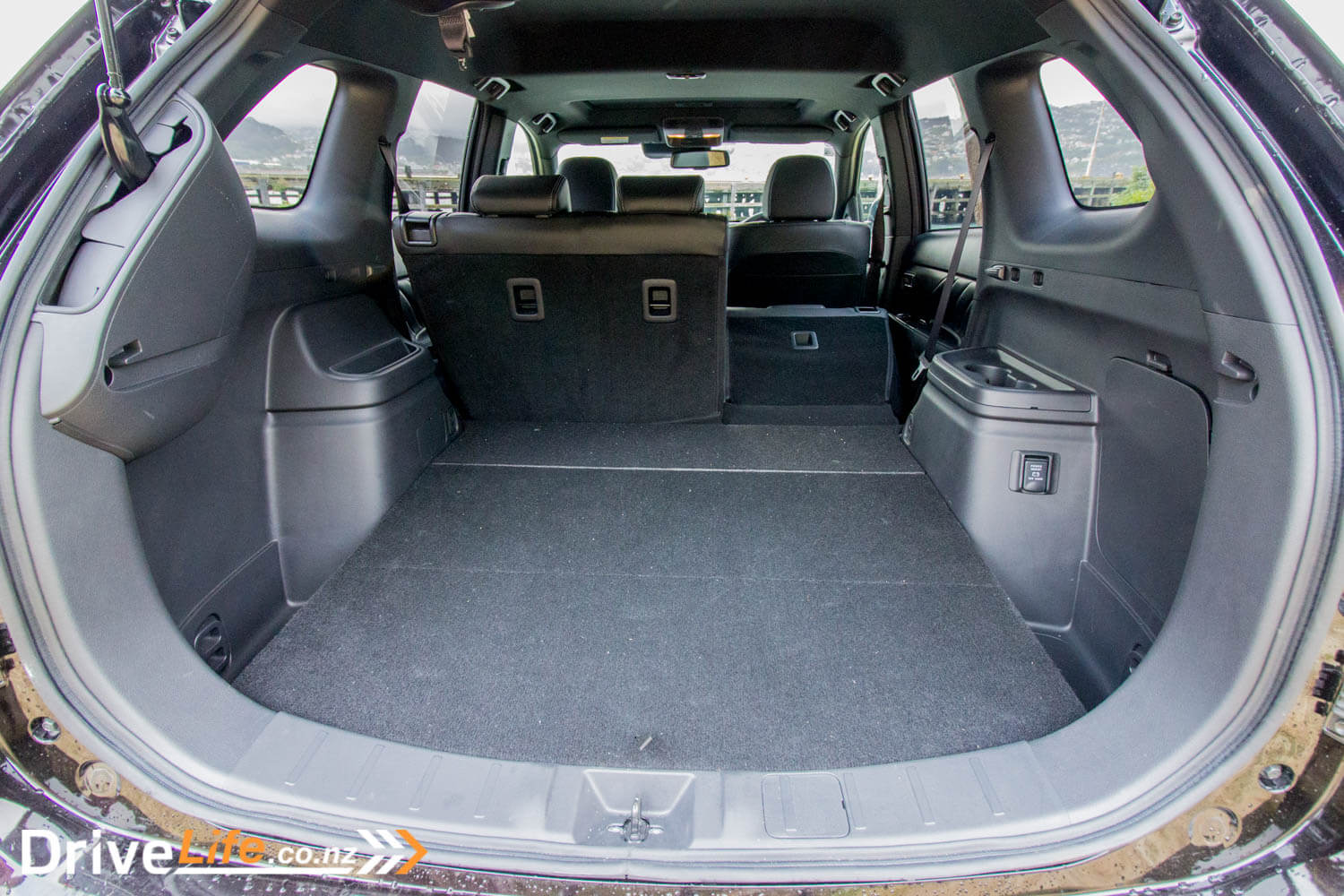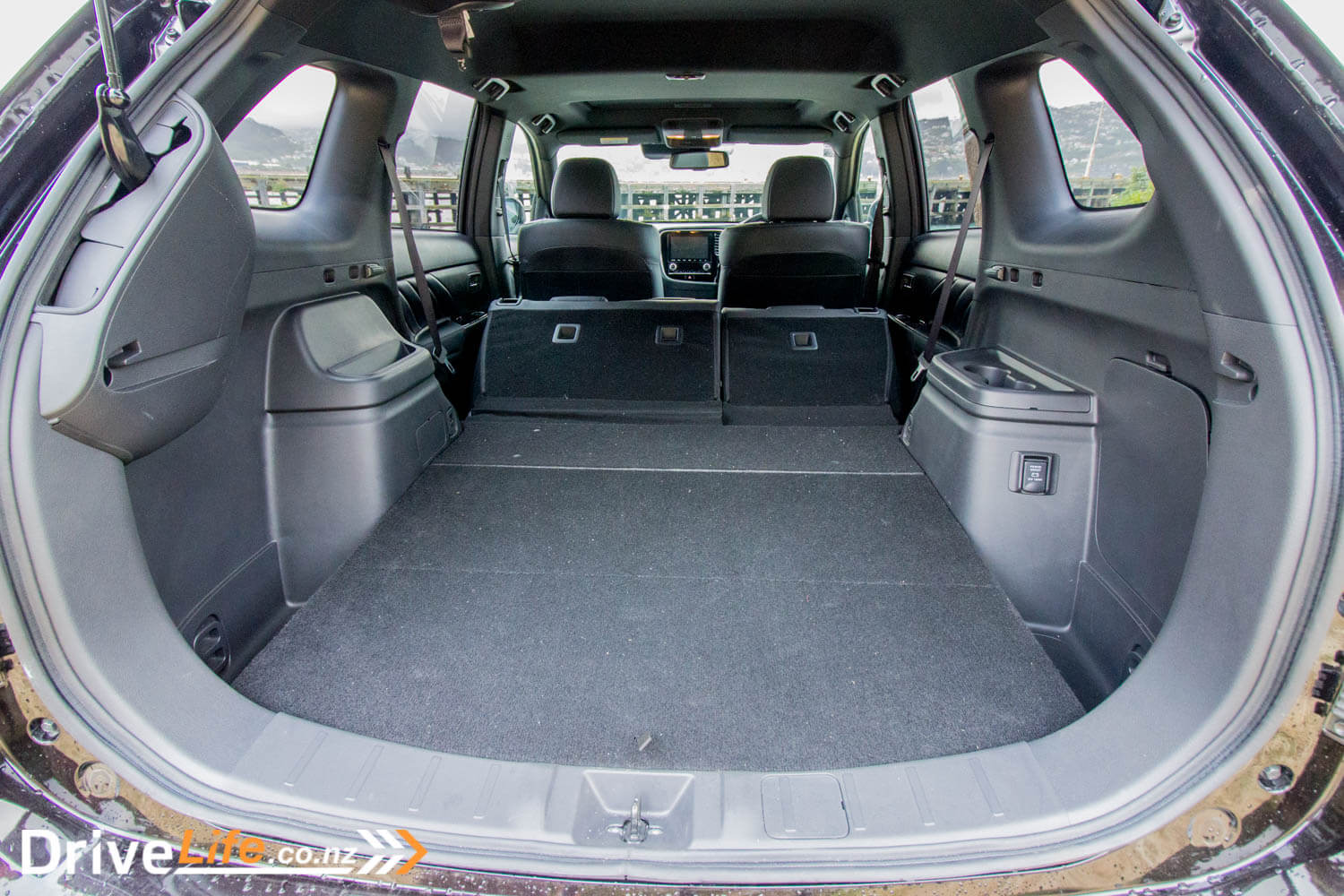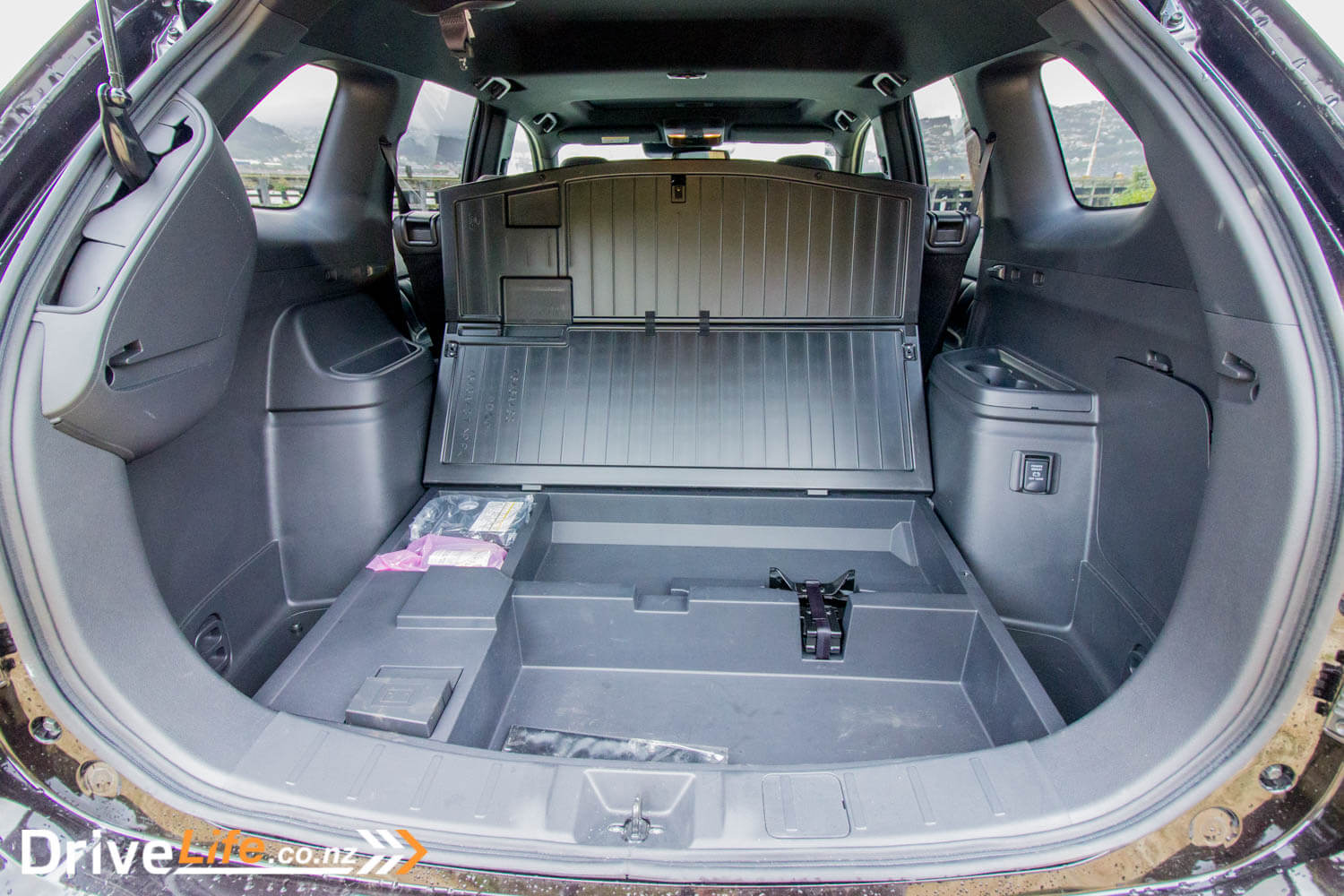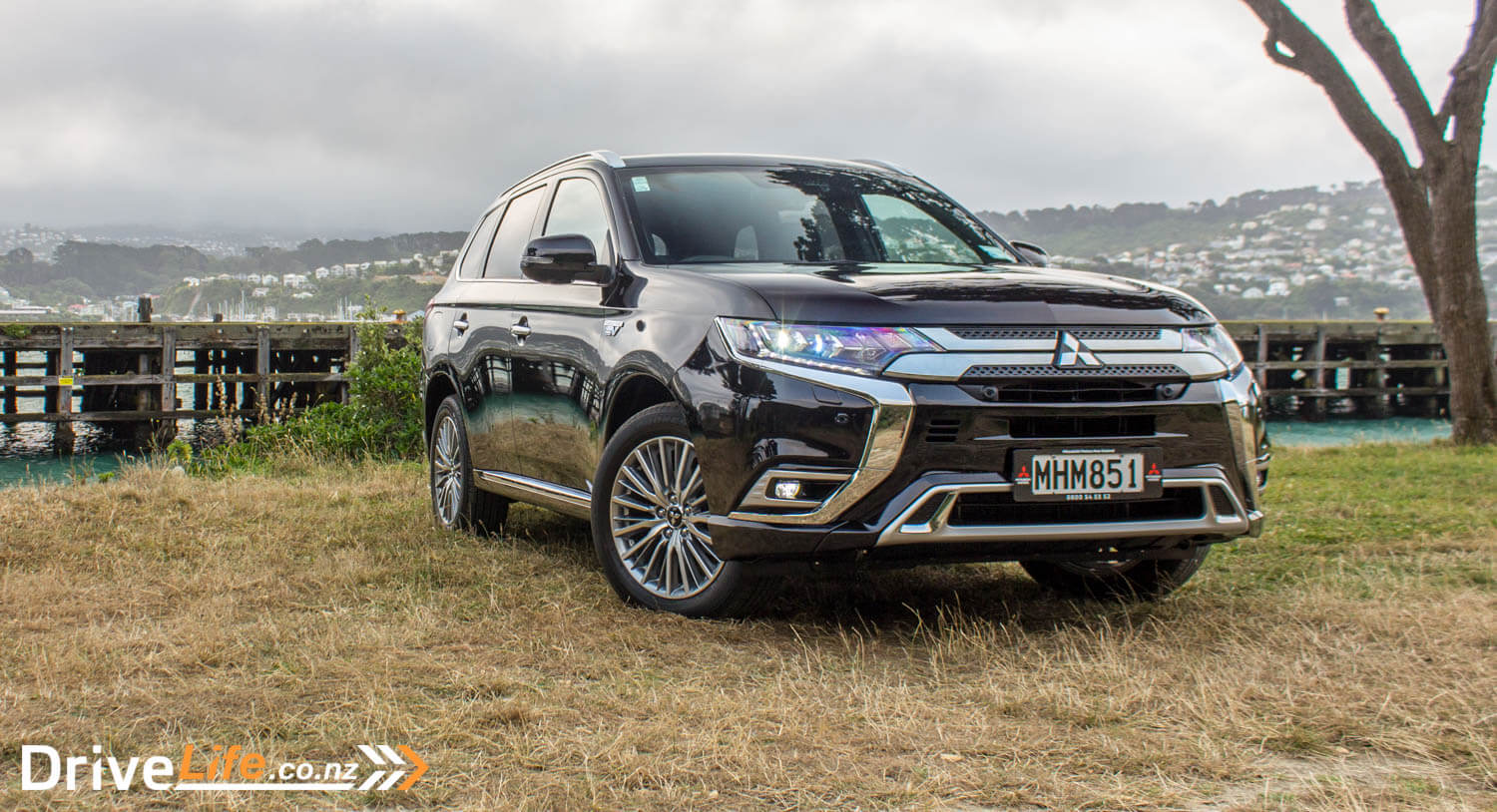We’ve always liked the Outlander PHEV at DriveLife – in fact, all of the Outlanders are pretty good, with the PHEV having that plug-in hybrid edge over its siblings. For the uninitiated, PHEV stands for Plug-in Hybrid Electric Vehicle. Basically it means you have a larger battery pack than a car that’s only a hybrid, and you can plug it in to charge it up. It’s a better system than simply a hybrid car.
With 2020 comes an updated Outlander PHEV; not too much has changed, a tweak here, an addition there. Probably the biggest change visually is an update to the front and mechanically, a move to a 2.4-litre engine, and a slightly bigger battery pack. The outgoing model is rated at 12kW capacity, while the new one is 13.8kW.
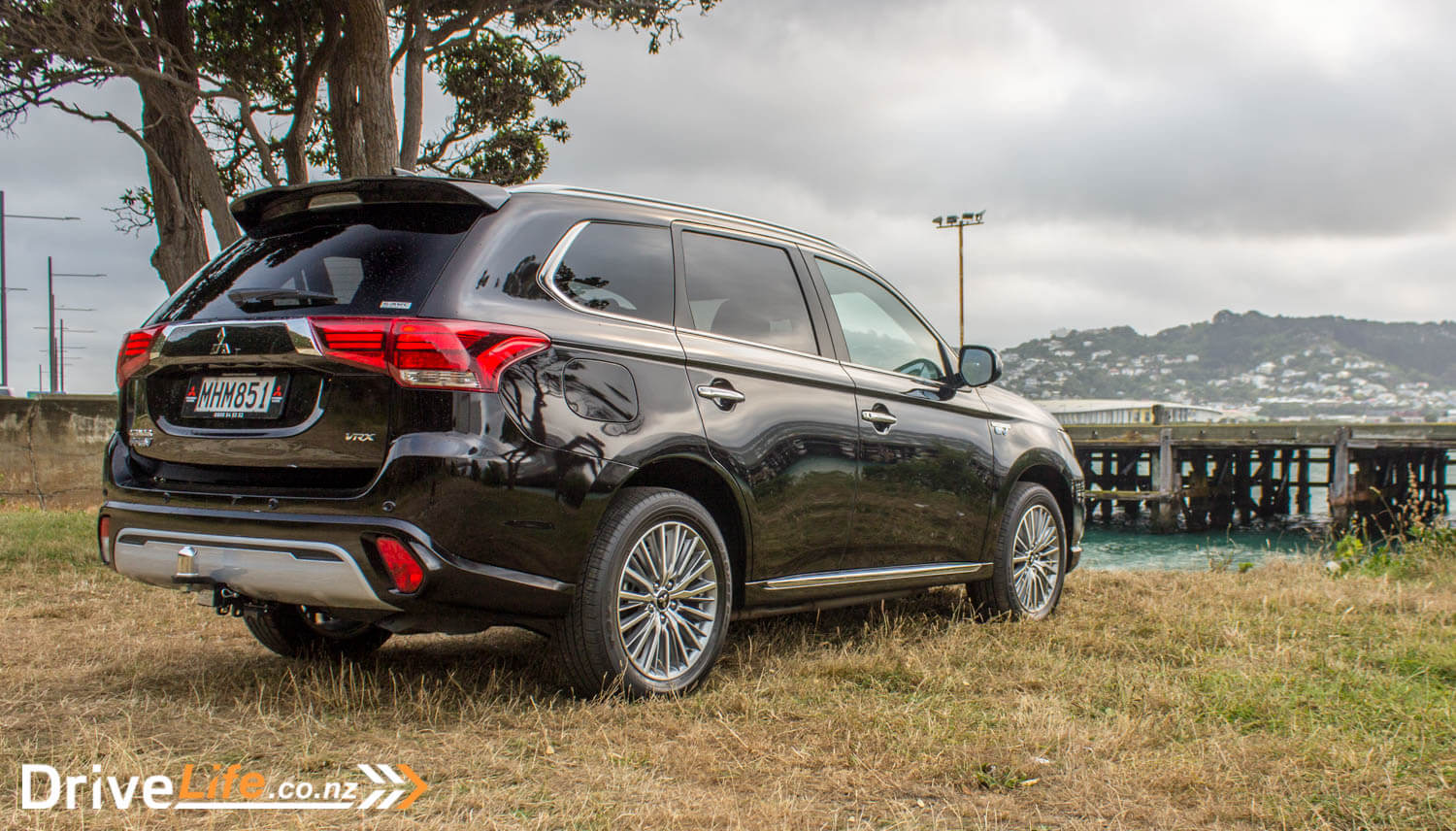
Is the Outlander PHEV getting a little dated? Sure it is – looking at exterior and interior pics from the early days of the model, you can see little has changed.
Are there better options? We still get people saying, “I’ll buy a Toyota RAV4 Hybrid”, but they aren’t plug-in, and that’s where the Outlander has it all over the slightly cheaper RAV4. Can the Outlander PHEV still hold its own against its competition – the Kia Niro PHEV or Mini Countryman PHEV?
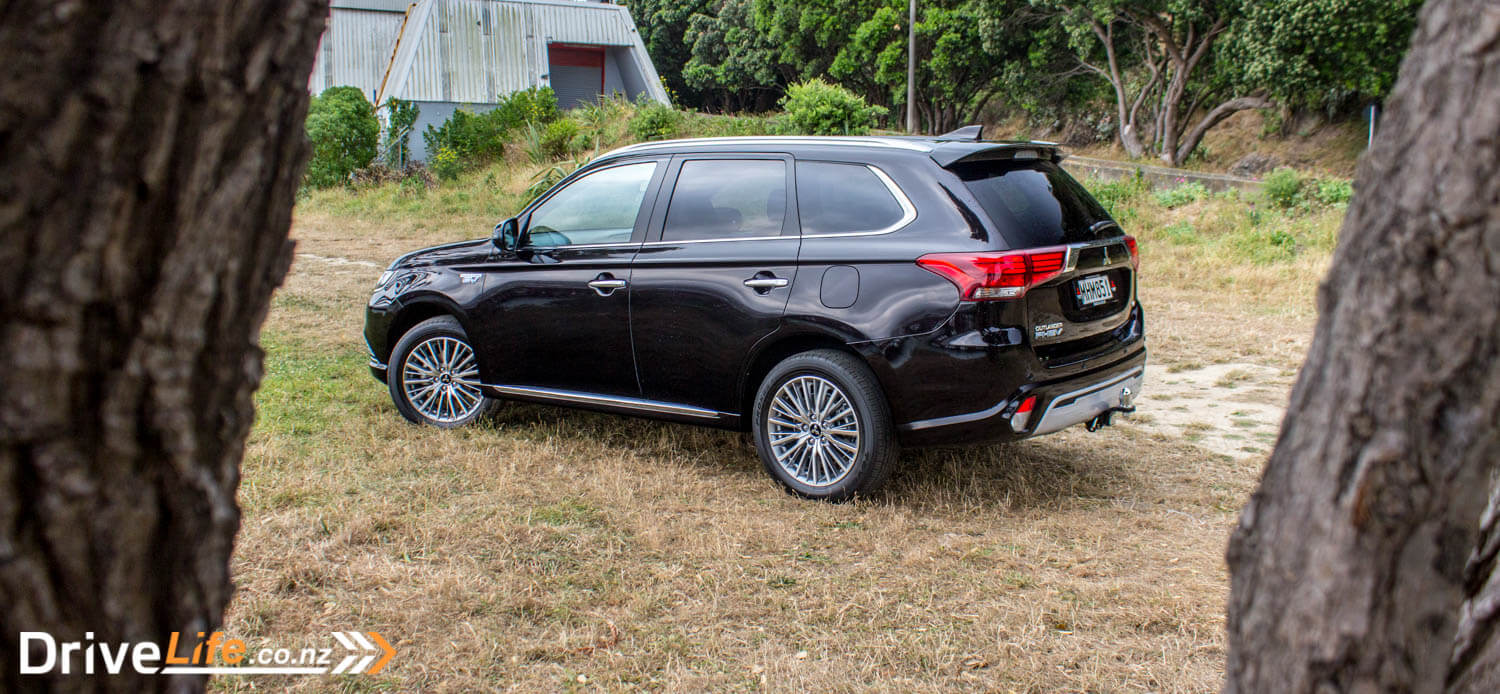
What’s In The 2020 Mitsubishi Outlander Range?
You can read about the range in our previous VRX diesel review, so we’ll stick only to the PHEV model here.
There are two models of Outlander PHEV; the XLS and the VRX. Changes from the previous version include the already mentioned front end, the bigger battery pack, a Sports mode, some minor other switchgear tweaking,
The standard central touchscreen is now 8” in size and includes pinch and zoom and DAB radio, and across both models is Android Auto/Apple CarPlay capability, front seats are heated, Blind Spot Warning is standard, as is rear cross traffic alert, hill start assist, a reversing camera, auto wipers, rear parking sensors, a speed limiter, adaptive cruise control, Forward Collision Mitigation with Pedestrian Detection, Lane Departure Warning, 18” alloy wheels, LED DRLs, LED taillights, heated and power folding exterior mirrors, keyless entry and start, headlight washers, auto high beams, automatic headlights, cloth seats, and 6-speaker audio.
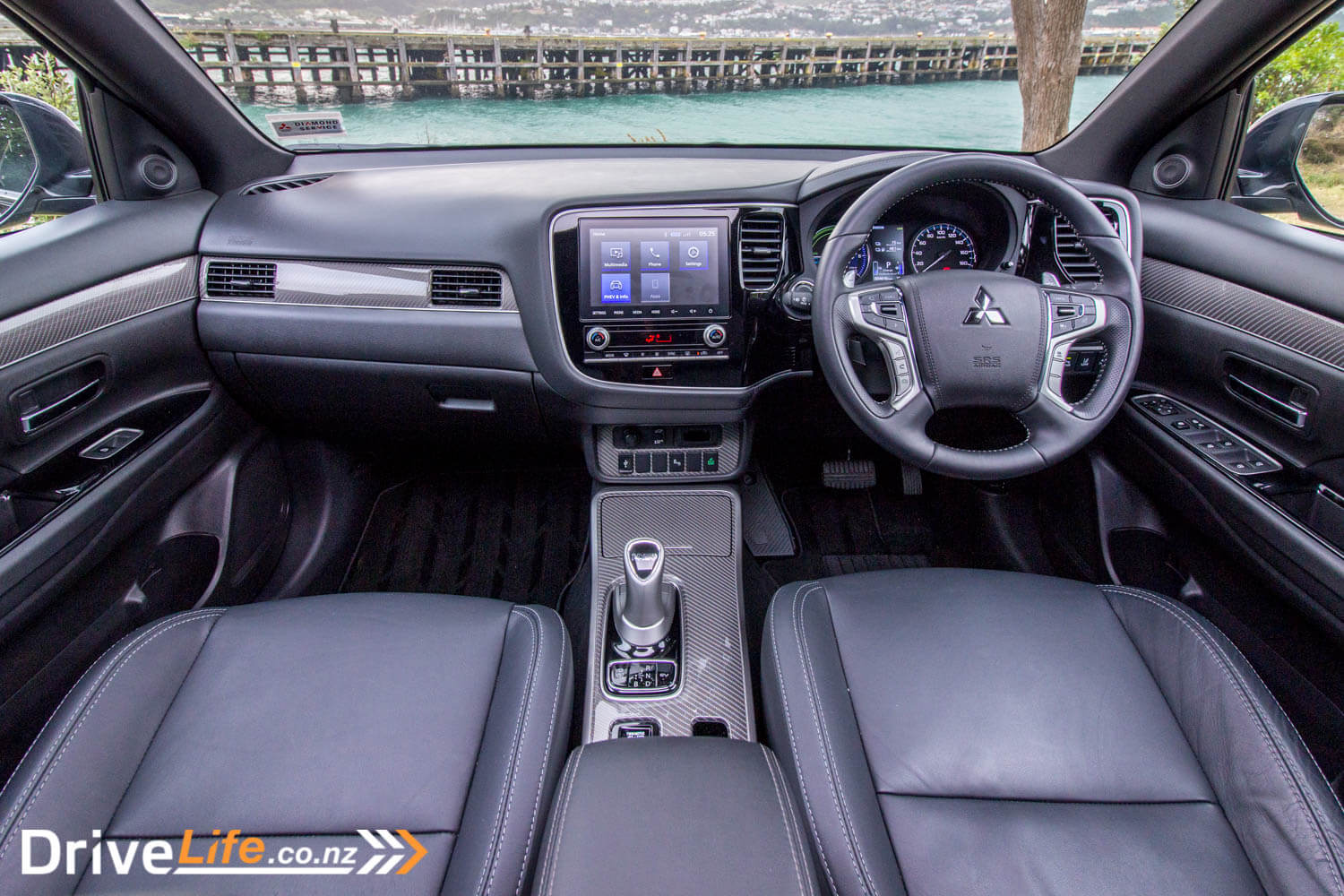
If you stump up for the VRX model, you also get an electric sunroof with manual blind, leather seating, power driver’s seat, an electric tailgate, and a few changes to the exterior trim.
The XLS has what Mitsubishi calls a ‘Recommended Special Price’ (RSP) of $52,990 (RRP $61,990) and the VRX an RSP of $57,990 (RRP $68,990).
There are 5 colours available; Sterling Silver, Titanium, Red Diamond, Cardrona, and Ruby Black.
You can read more about the Outlander PHEV on Mitsubishi New Zealand’s website.
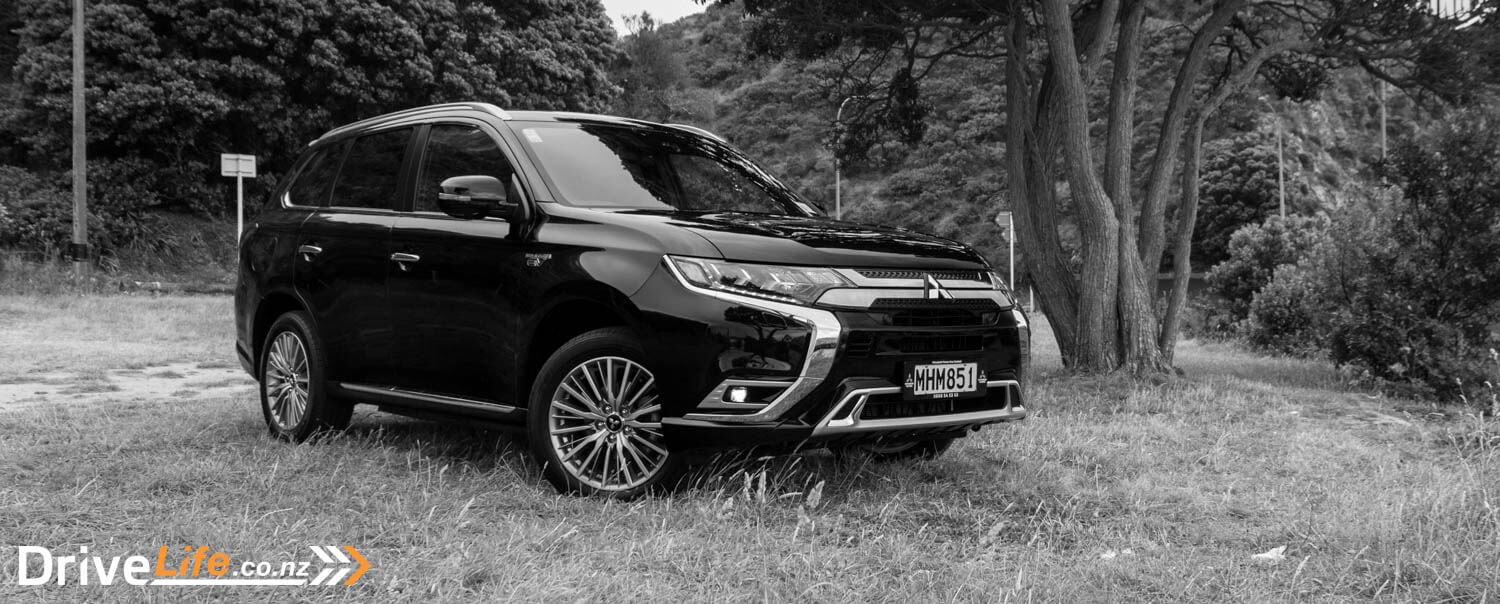
First Impressions Of The 2020 Mitsubishi Outlander PHEV VRX
It may be long in the design tooth, but it still looks ok. Certainly not sharp edged like a RAV4, but you aren’t buying an Outlander for its looks.
The front has adopted the latest Mitsubishi family look, with the big bold headlights and garnishes. Side on, the car looks unchanged from when it was launched in 2012. It’s hard to tell if a single line has changed.
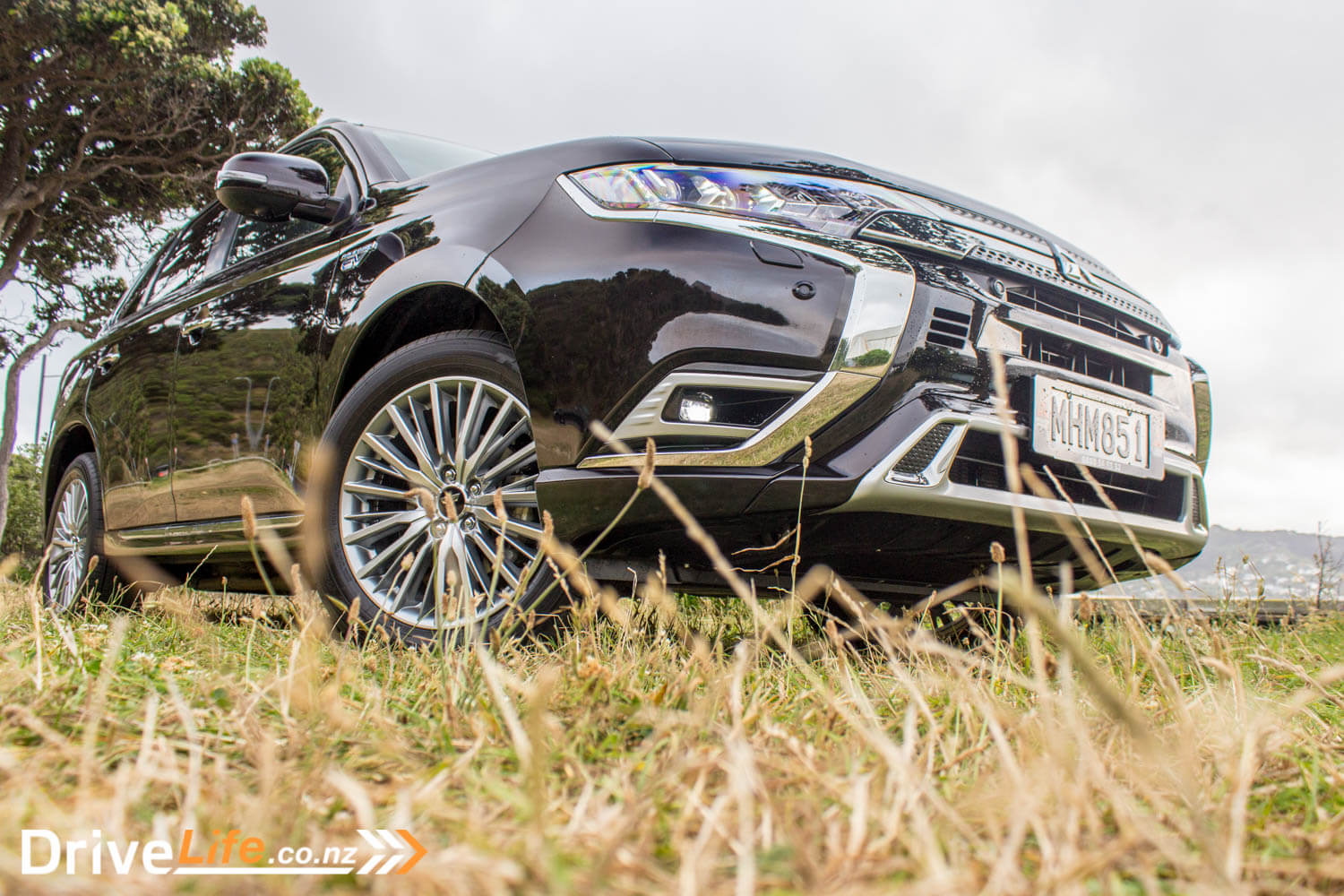
At the rear, new horizontal LED taillights are present, trying to modernise it for 2020.
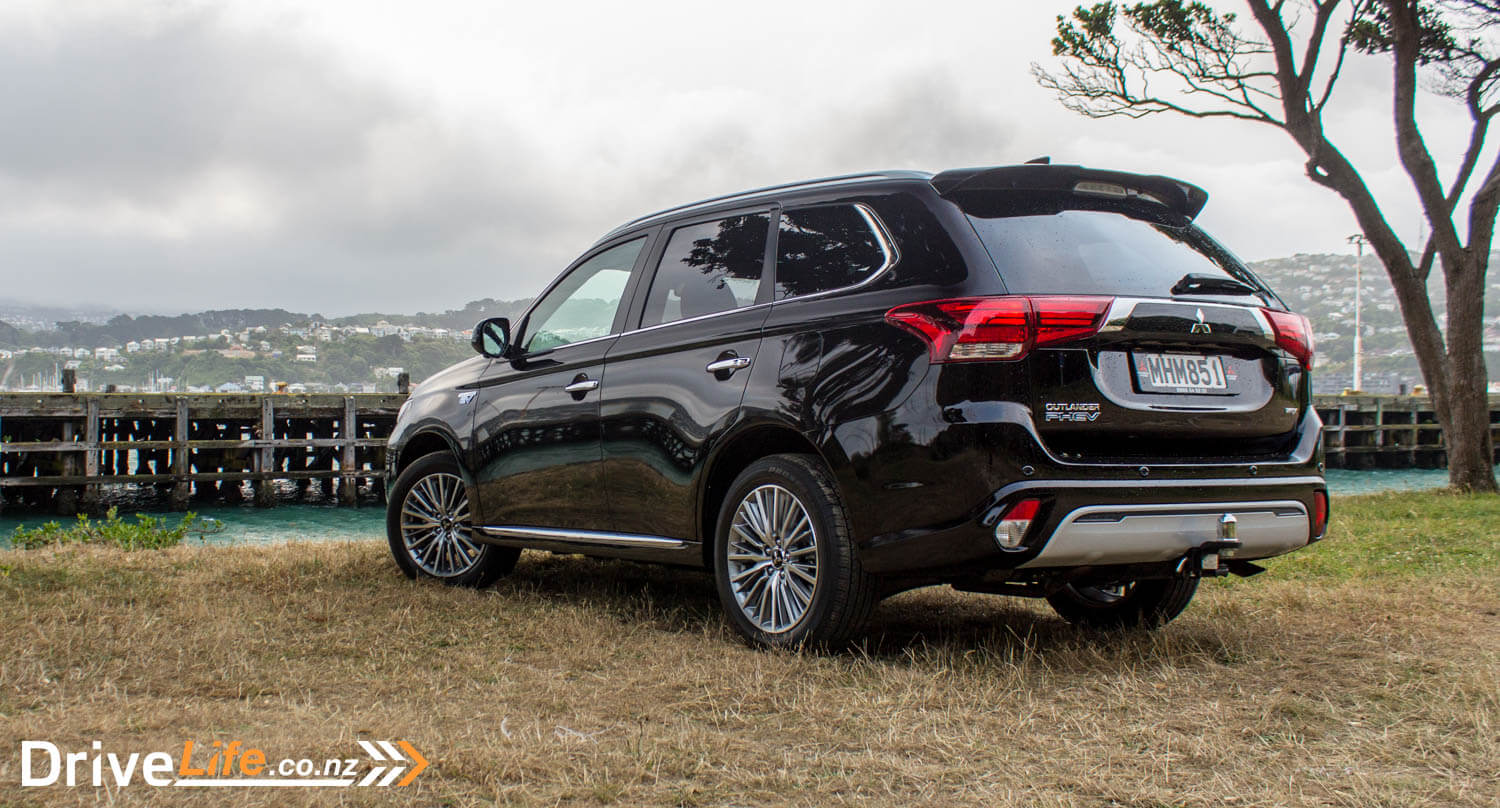
What’s The Interior Like On A 2020 Mitsubishi Outlander PHEV VRX?
After just dropping off the new ASX and getting into the Outlander, it was a big case of déjà vu. Like the ASX VRX, the Outlander PHEV VRX is all black inside, which can make it a very hot car to return to on a sunny day. There is an opening electric sunroof with a manual blind, but it’s not panoramic. It’s still good for letting some natural light into the cabin, but I did forget to close the blind some days, which helped with the microwave effect.
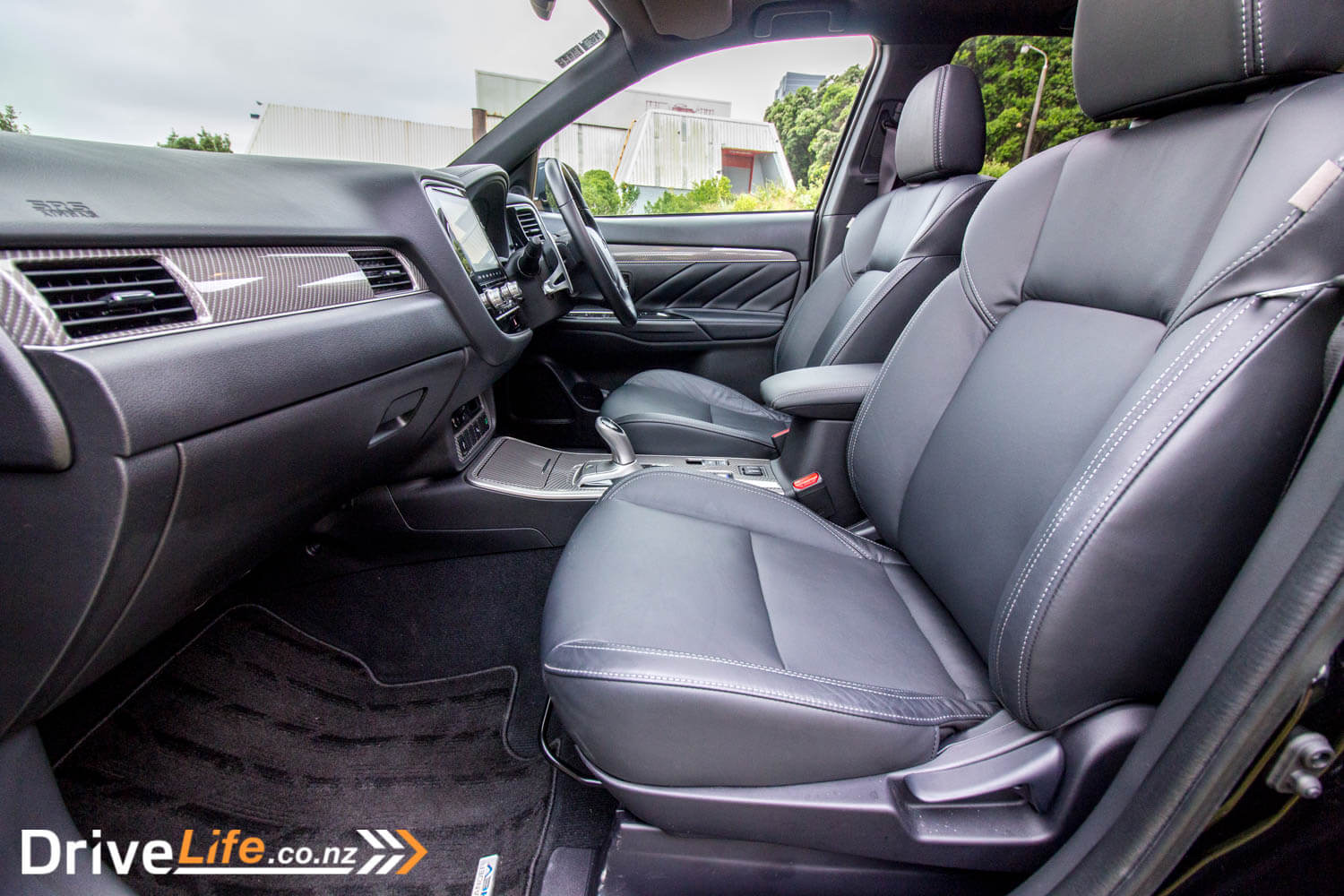
Headroom is at a bit of a premium front and rear, as that sunroof sucks up a lot of available space. It’s a shame it can’t be deleted from the car, as for me I’d rather not have it at all. On the plus side, the headlining does raise up for the rear passengers where the sunroof finishes, and this also means a higher cargo area.
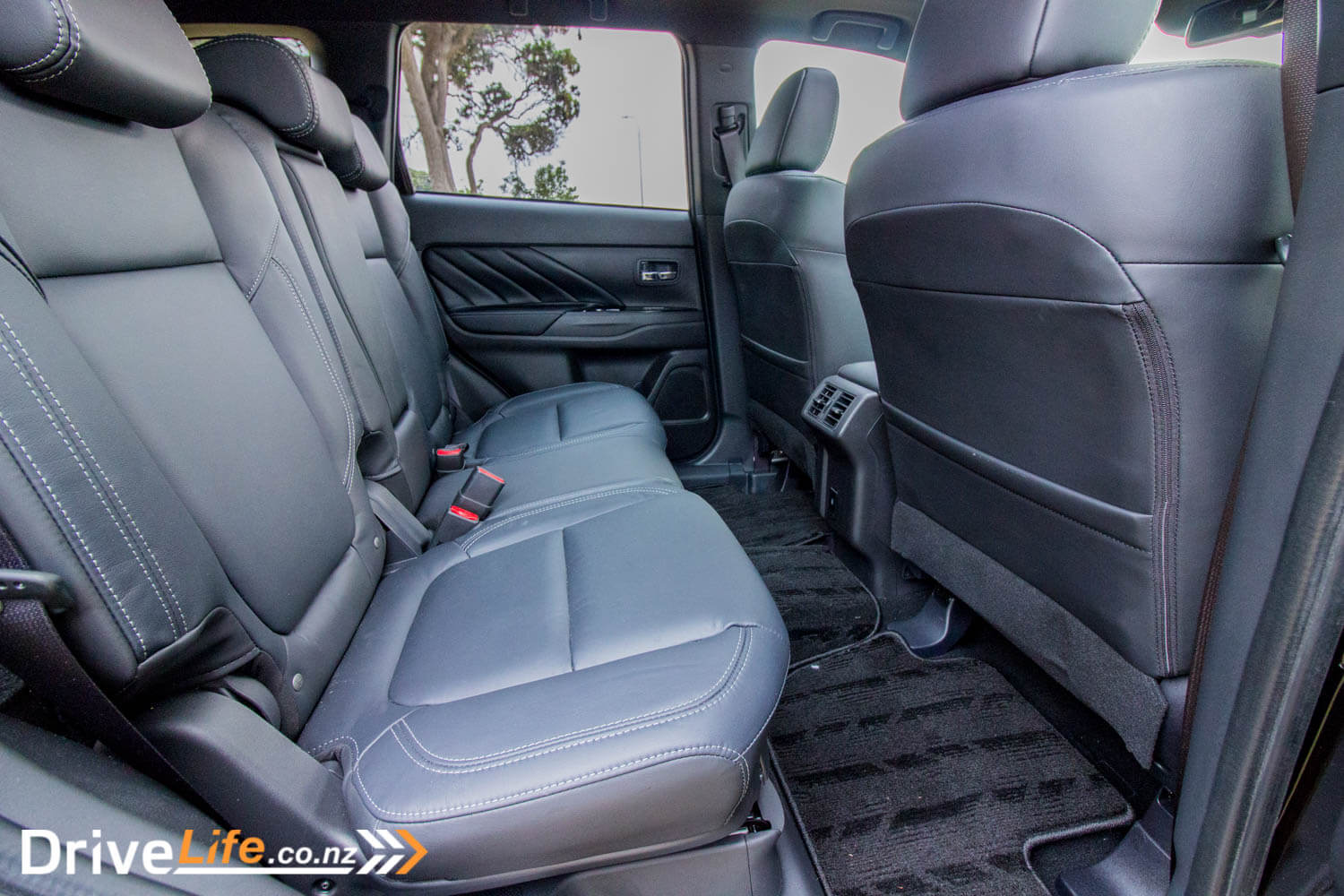
Again like the ASX, the PHEV has the same 1980s heated-seat rocker switches. These would be cool if the whole car was trying to be retro, but honestly, they look cheap. The PHEV is starting to look a bit dated inside up front; there’s a bigger main central screen now, and some tweaking of the AC switches, but still, the dashboard design is lagging behind others in the market now. Does that matter to driving it? Not at all.
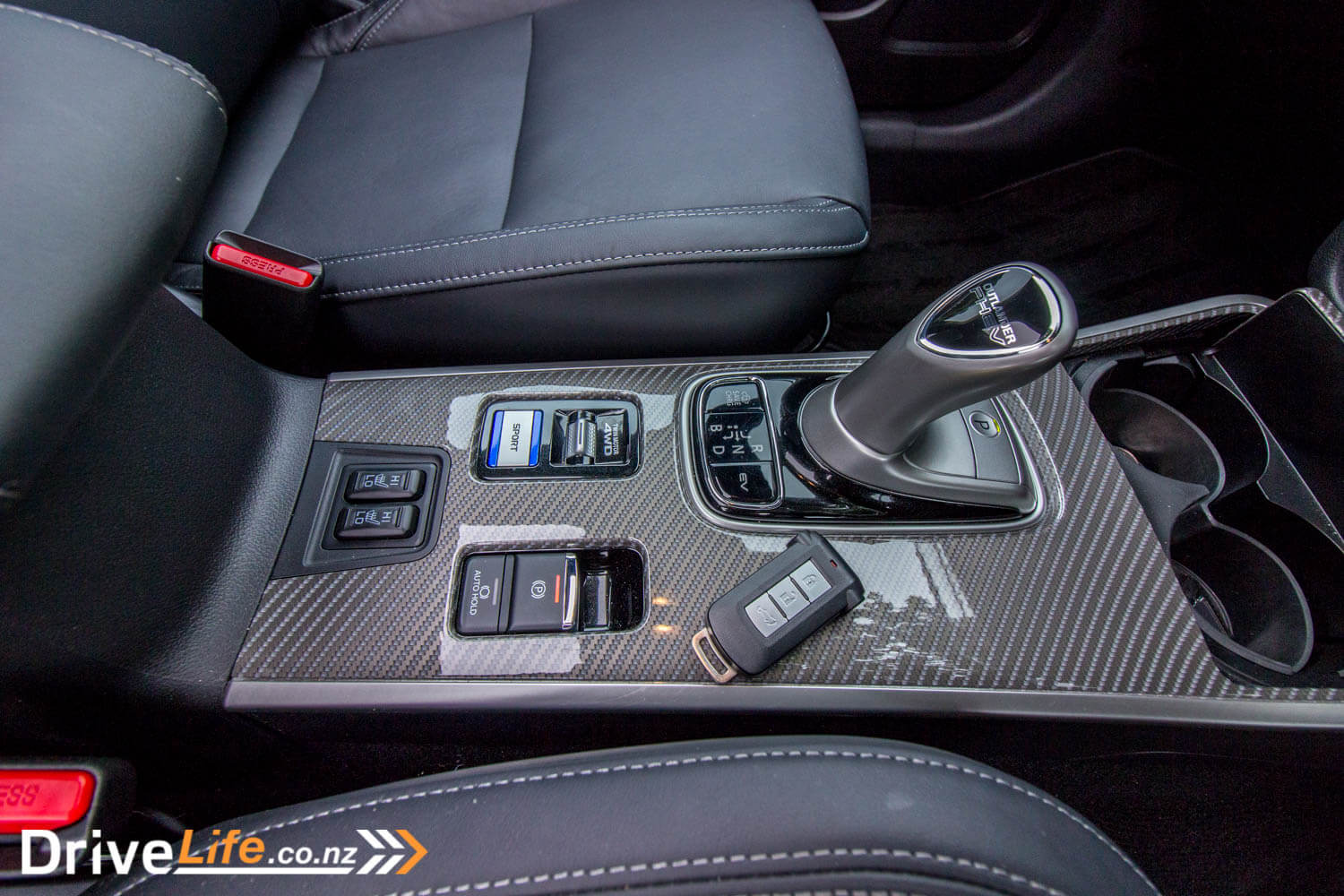
Good to see Mitsubishi hasn’t mucked about with rear legroom – there’s gallons of it back there.
Since this is the PHEV model, you lose the 7-seat capability of the petrol or diesel Outlander models, since there’s now an electric motor under the floor. But that does mean a large cargo area at 463 litres with the second row up, and nicely flat. A shame the rear seats don’t go anywhere near flat when folded down though.
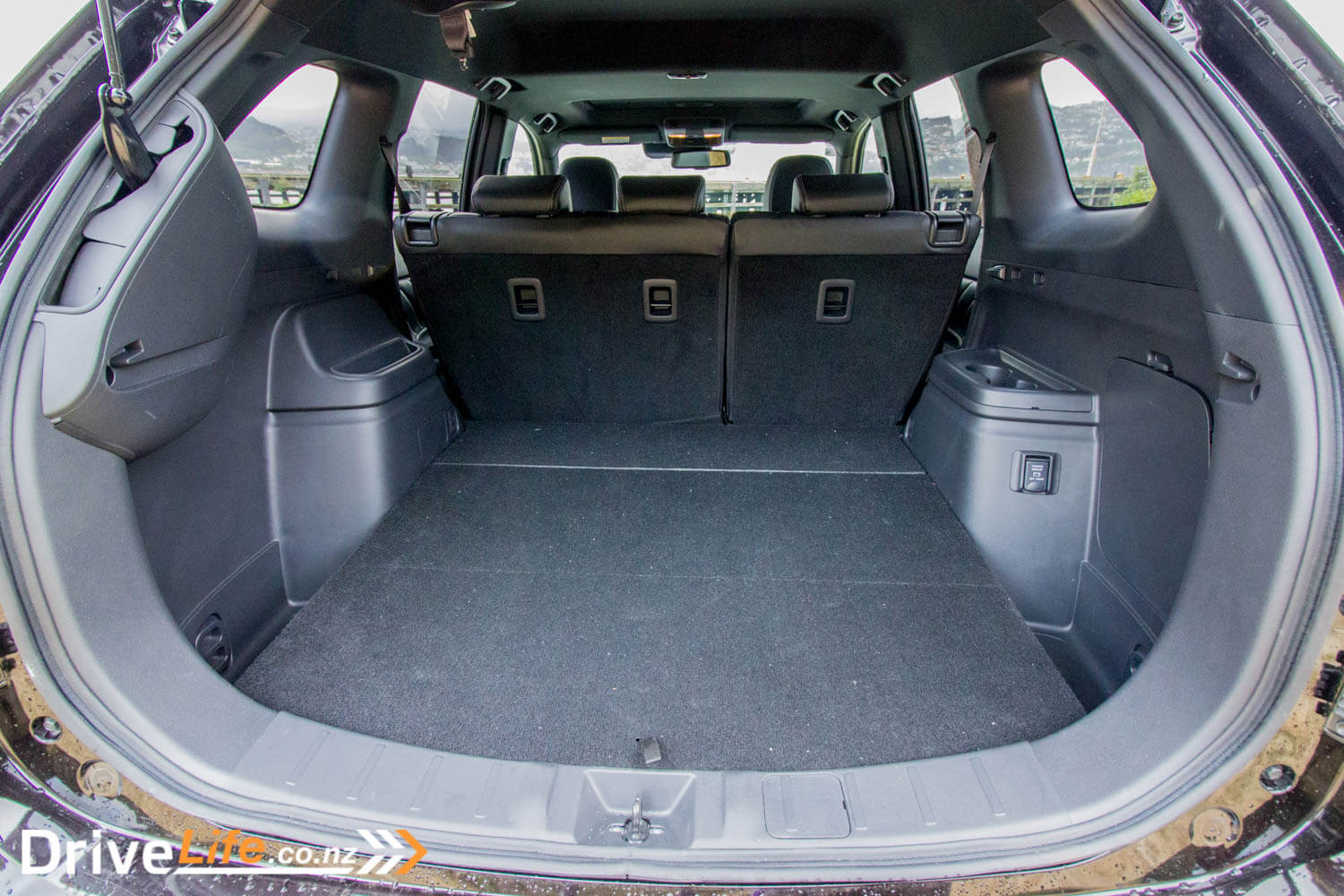
What’s The 2020 Mitsubishi Outlander PHEV VRX Like To Drive?
When I picked the PHEV up, the range in the tank was 550km. It seemed low, but memories of testing the previous model which got me 850km stuck in my head. No need to worry about it just yet.
One new feature is the 360-degree camera on the VRX model, and it’s simply operated by a single button on the steering wheel. That’s great, as some brands still make it a bit of a mission to find that button. The image is reasonably clear, and when you start moving, the rear view switches off and you are left with the left-front wheel view, which is typical.
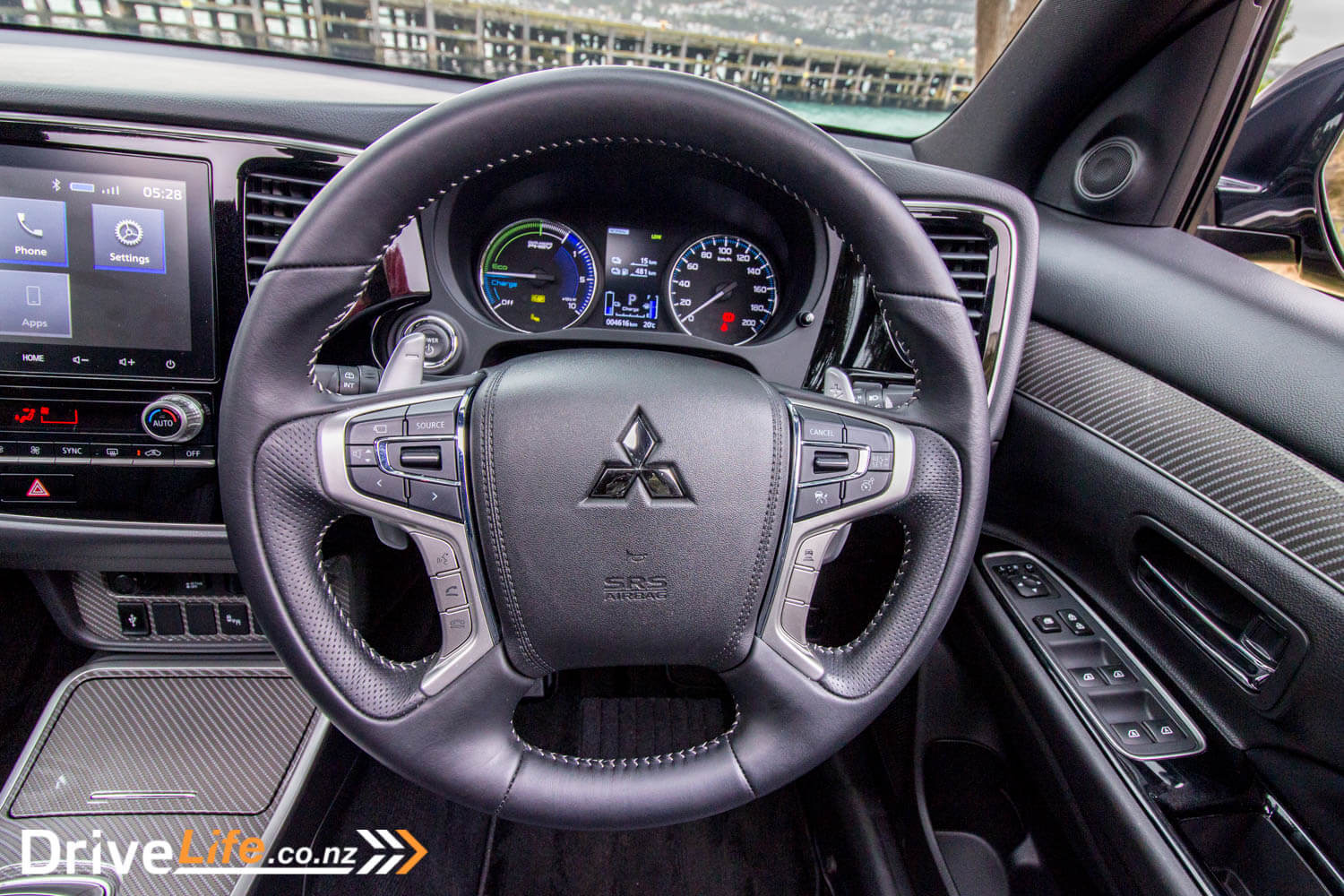
The rest of the steering wheel controls are simple and easy, and after a time of learning don’t need many look-downs to see what you are pressing.
The paddles on the rear of the steering wheel control the brake regeneration (regen), and I’m not sure if the previous model did this, but they don’t move with the wheel. Not the end of the world, but if you are going downhill around a long bend (hellooo, Wellington), it’s nice to be able to adjust the regen simply and safely, with both hands on the wheel. However, this is tricky when the paddles are fixed. You can also adjust it by using the gear lever, but this means one hand is off the wheel.
There’s been no change from the previous model in the gear lever itself. I’m still not sure why it has a ‘B’ (brake regen) position, when you can just use the paddles.
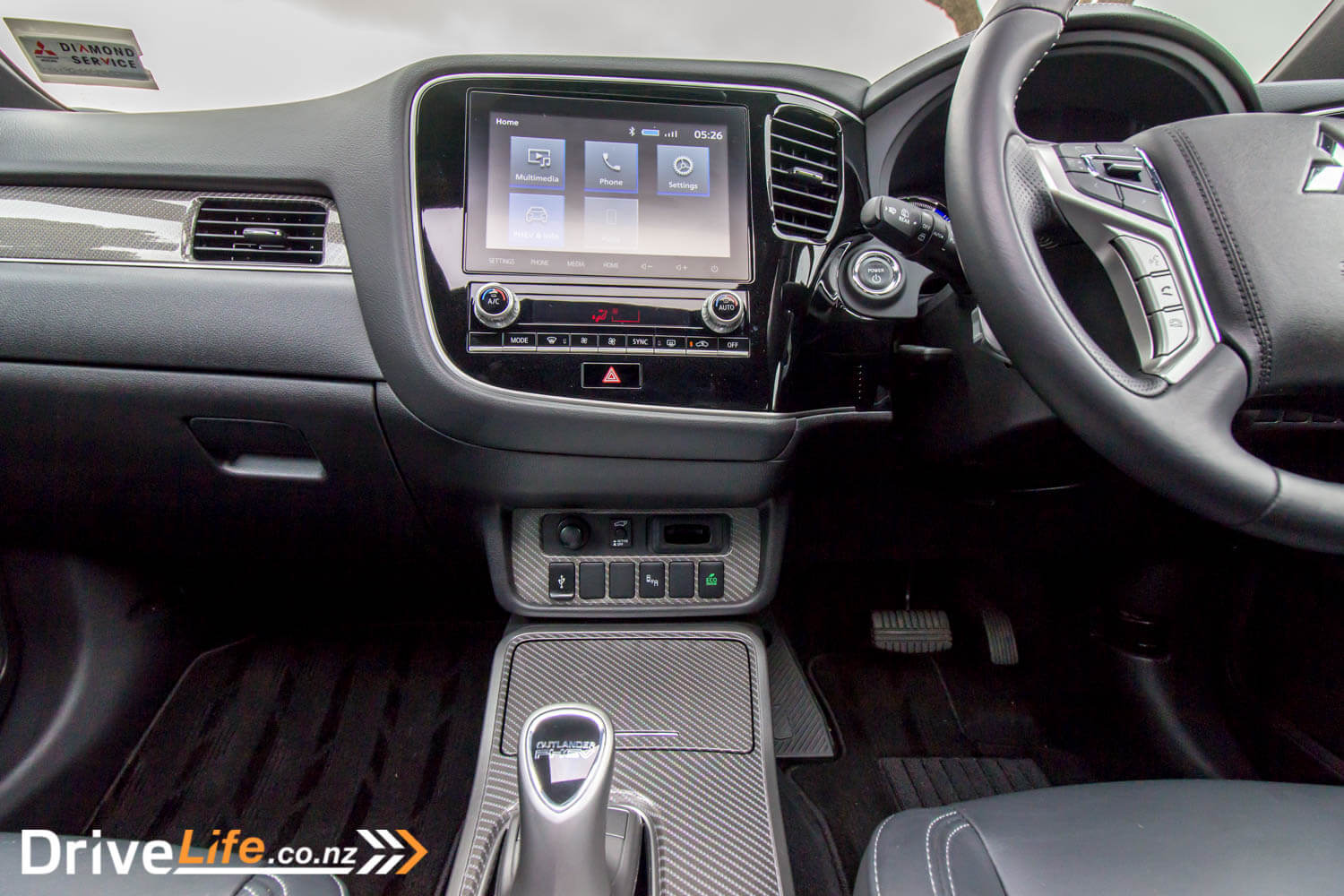
Mitsubishi have played around with the other buttons, merging the Save/Charge/Normal buttons into a single button, and then adding a Sport mode button. I’m not sure Sport mode is really necessary in the PHEV, but it does make the car get up and go a whole lot more. If you’ve driven other EVs, you may be a little disappointed in the off-the-mark performance of the Outlander PHEV in Normal mode; it’s sprightly off the line if you plant it, but it sure doesn’t have that same linear performance that you get with a full EV. Stick it in Sport mode though, and it will impress you more. But it will of course use that petrol engine a lot more to give you that extra performance. One downer here, at least for me, is that a CVT automatic gearbox is used, so when you do floor it, you get CVT flaring, meaning a whole lot of engine noise, and seemingly not much acceleration in relation to the noise.
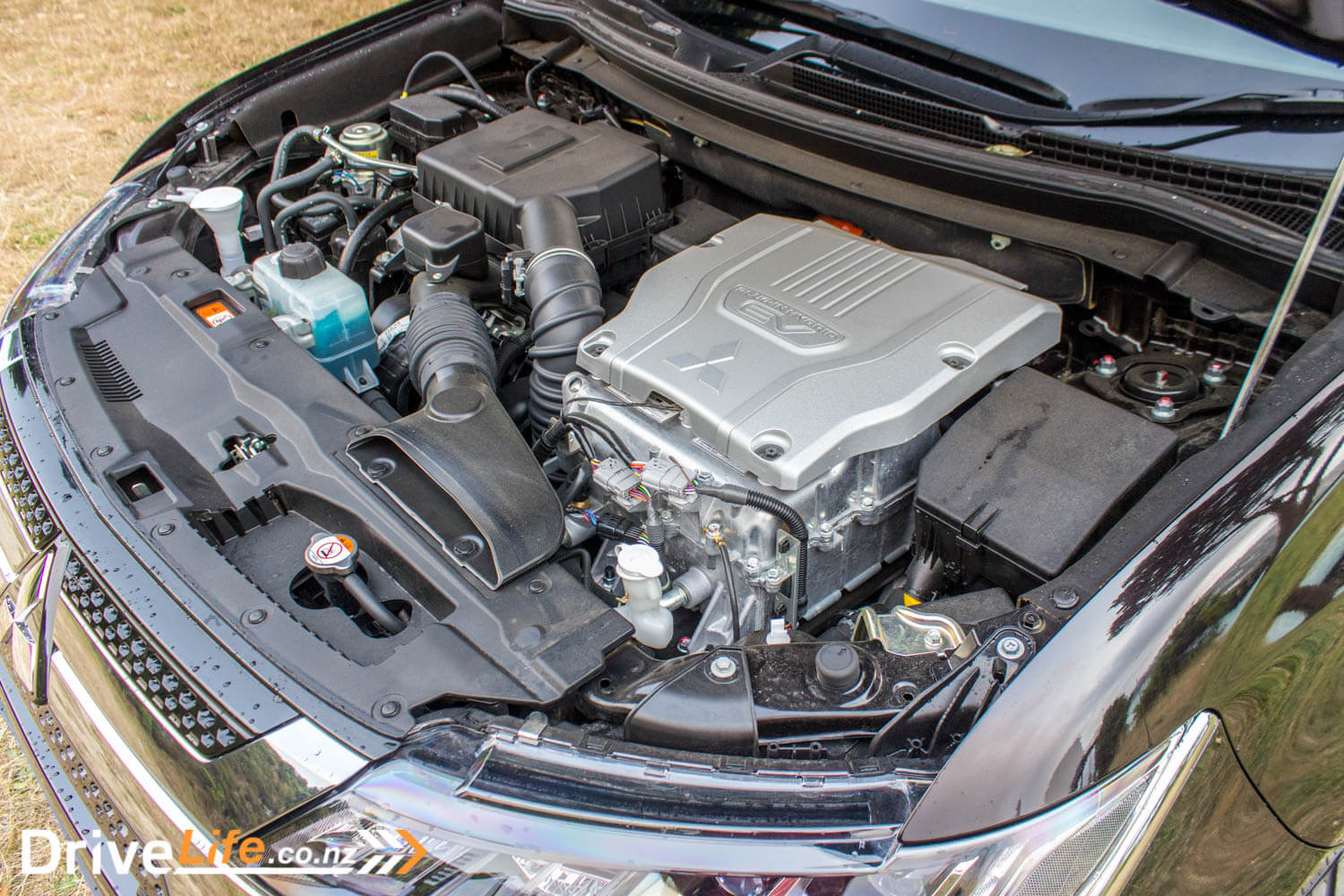
Behind the gear lever is also the 4WD modes button, where you can select from Normal, Snow or Lock. The PHEV is permanent AWD, with an electric motor driving the rear wheels, and a combination of another electric motor or the petrol engine driving the front.
There’s also an Eco mode button, and that does what it says on the packet. This does mean that there’s an EV button, a Sport button, an Eco button, a 4WD modes button, and the Save/Charge/Normal button. That’s a lot of buttons to contend with. But on the whole, you simply don’t need to touch them, just get in and go, as Normal everything works just fine. I did use the EV button quite a bit, to force the car to use only battery if I was shooting into town. Part of me however wishes Mitsubishi would simplify this. We keep saying if we want more PHEVs/EVs on the road, we need to make it simple. Having too many buttons isn’t simple for a lot of drivers, but again, if your significant other is freaking out about driving it, just get in and go, no need to play with any buttons.
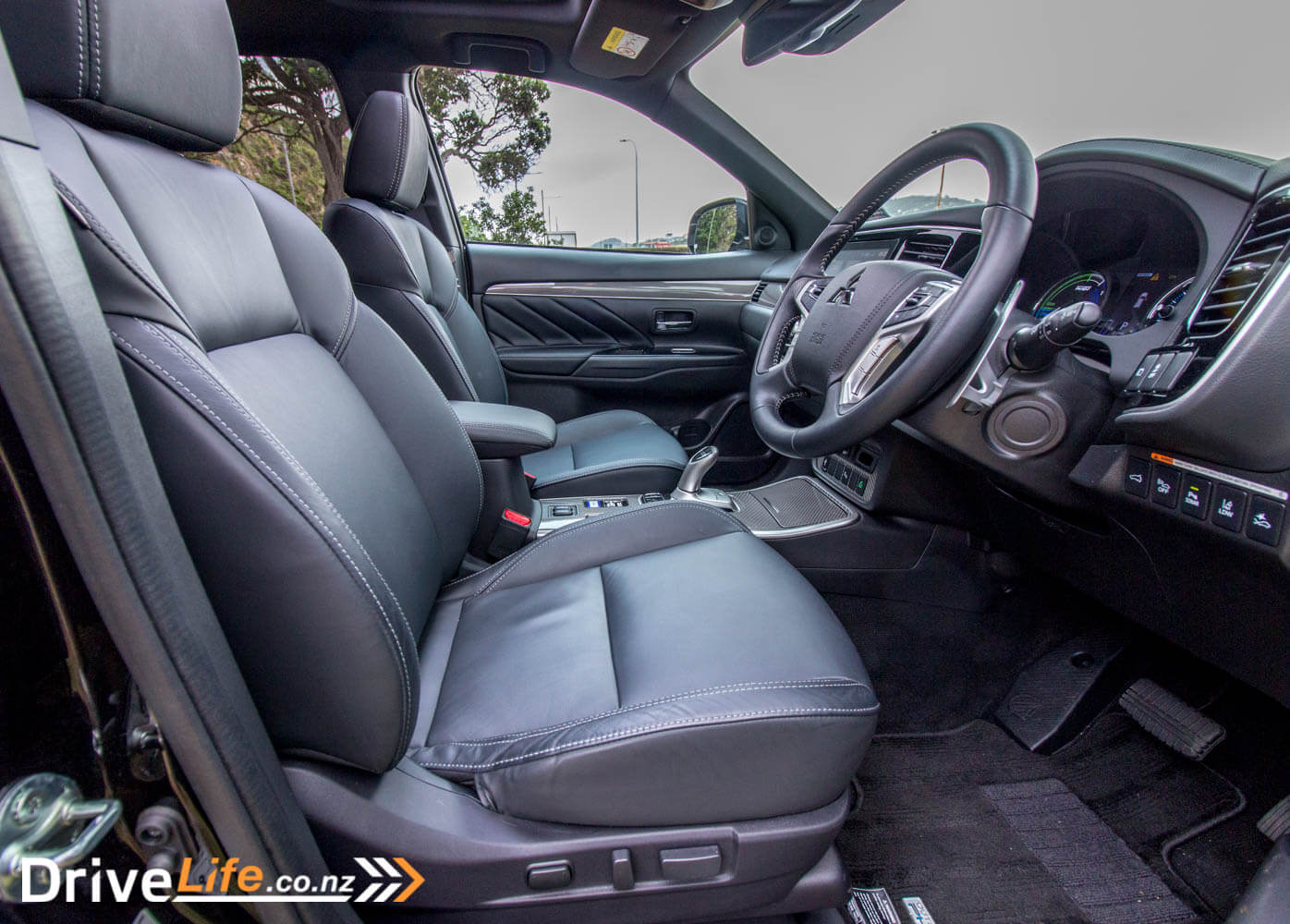
It was time for a commute to the office. This is a 40km trip each way, and I had three days of this. This means time to test out that new, bigger battery pack.
Day 1, and I stuck the car into EV mode – but not Eco mode. After an overnight charge, I had 59km of range – yes! Within a few hundred metres, this was down to 47km, which deflated my EV ego a bit. Regardless, I arrived with 8km left in the battery – a good start. On the way home, I put the car into Charge mode, which forces the petrol engine to start and charge the battery pack. It took a long time with the motor running to get some decent KM into the batteries, and I think there was 19km of range when I got home from my 40km trip.
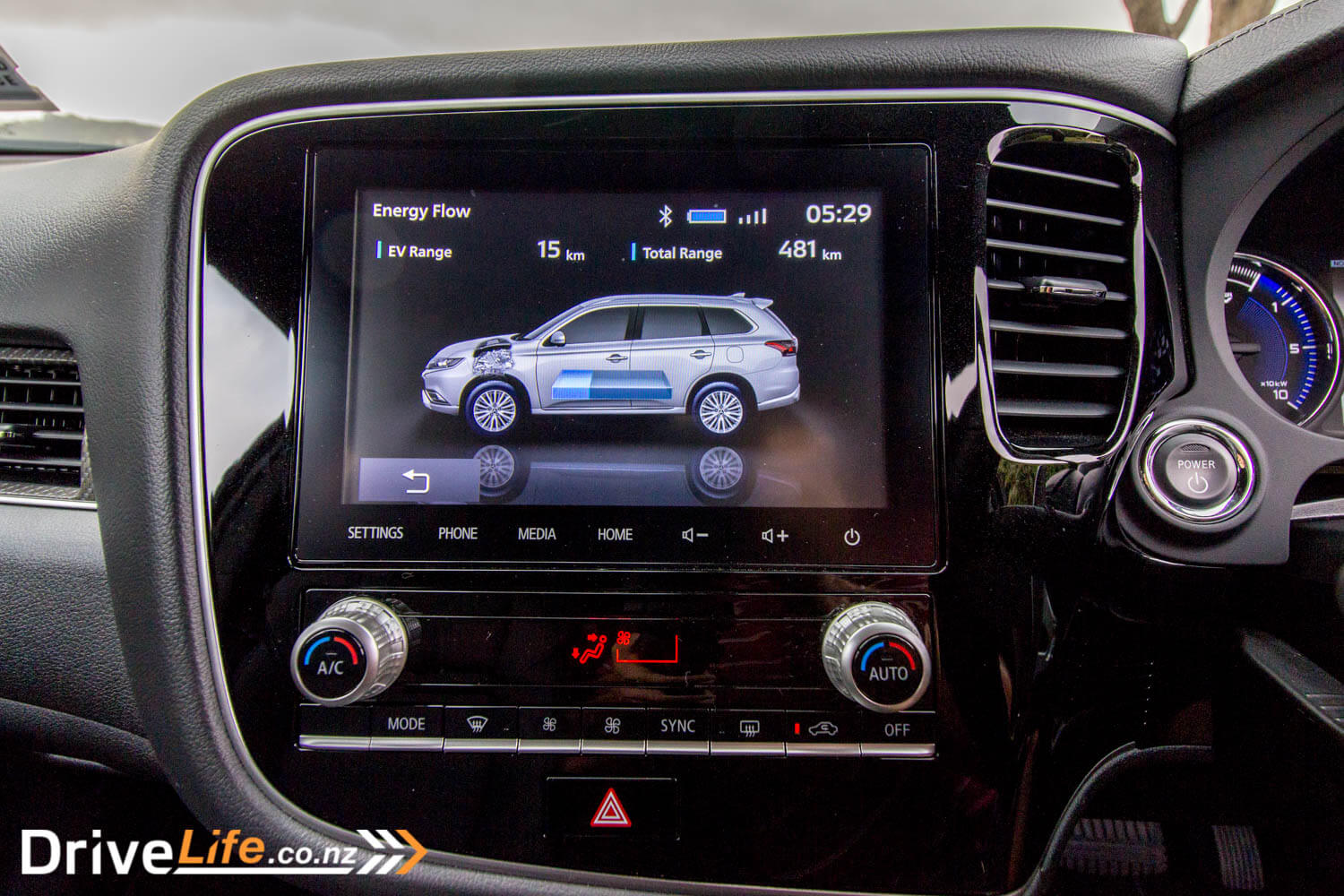
Day 2: Again I used EV mode, but also Eco mode. After my overnight charge, for some reason I only had 47 km of EV range. On getting to the office using the same route, I had 15km left – almost double what it was not using Eco mode. I really didn’t notice the dulled performance of using Eco mode in commuter traffic, and having double the range when I got there was a good result. I did notice Eco mode affected the air-con quite a bit, taking a large chuck of the coolness out of it. On the hot days we had during our test, this didn’t help.
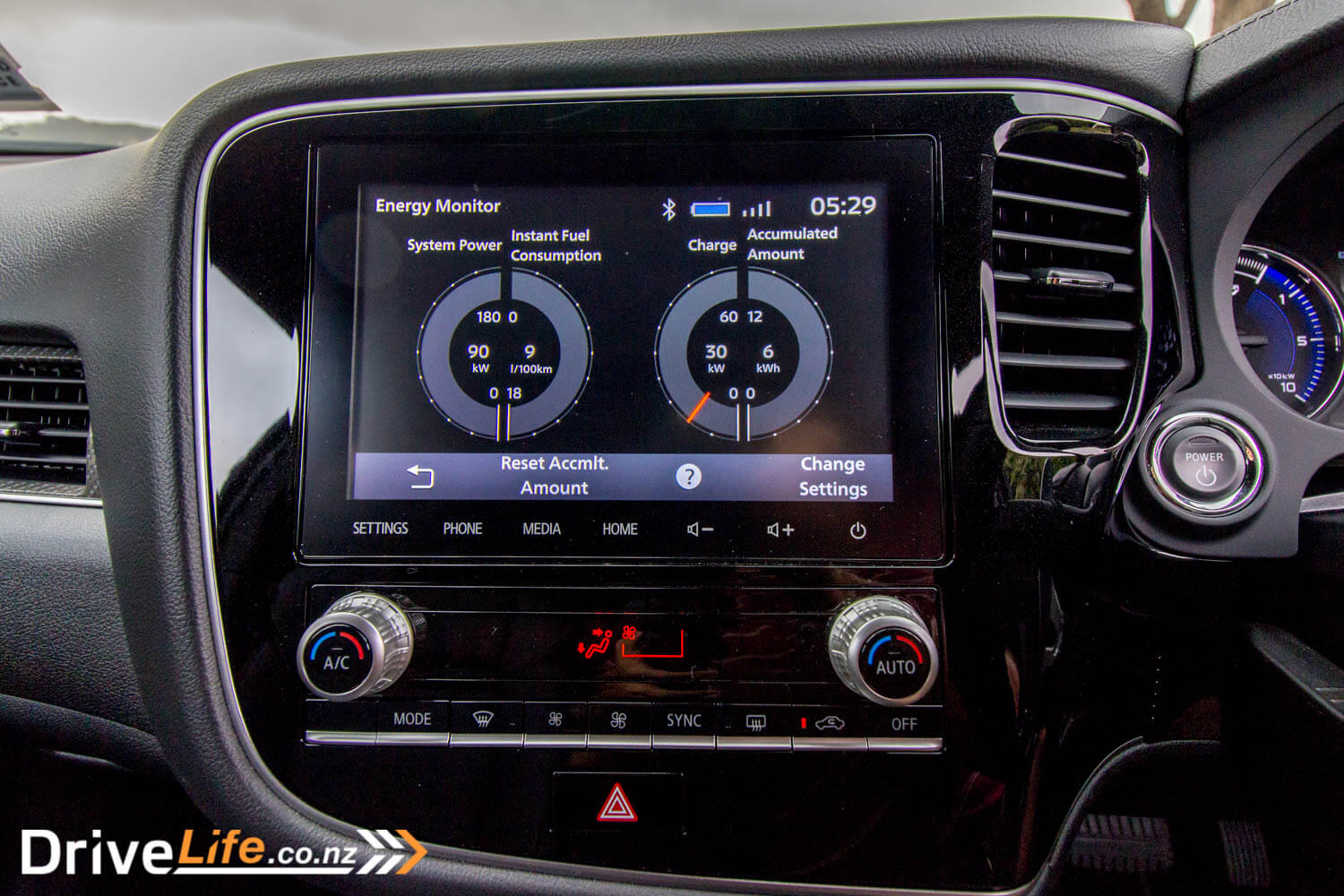
Day 3: Time for the new Sport mode, with 57km range leaving home. Sport mode defaults brake regen to B5 (max regen) mode, and of course uses the engine a lot more, and this affected my EV rating which plummeted to 36% – but I did have 33km left in the EV tank on getting to the office. If you’re in a rush, Sport mode does get you point to point more quickly, but honestly, I think just leaving the car in Normal mode is the way to go.
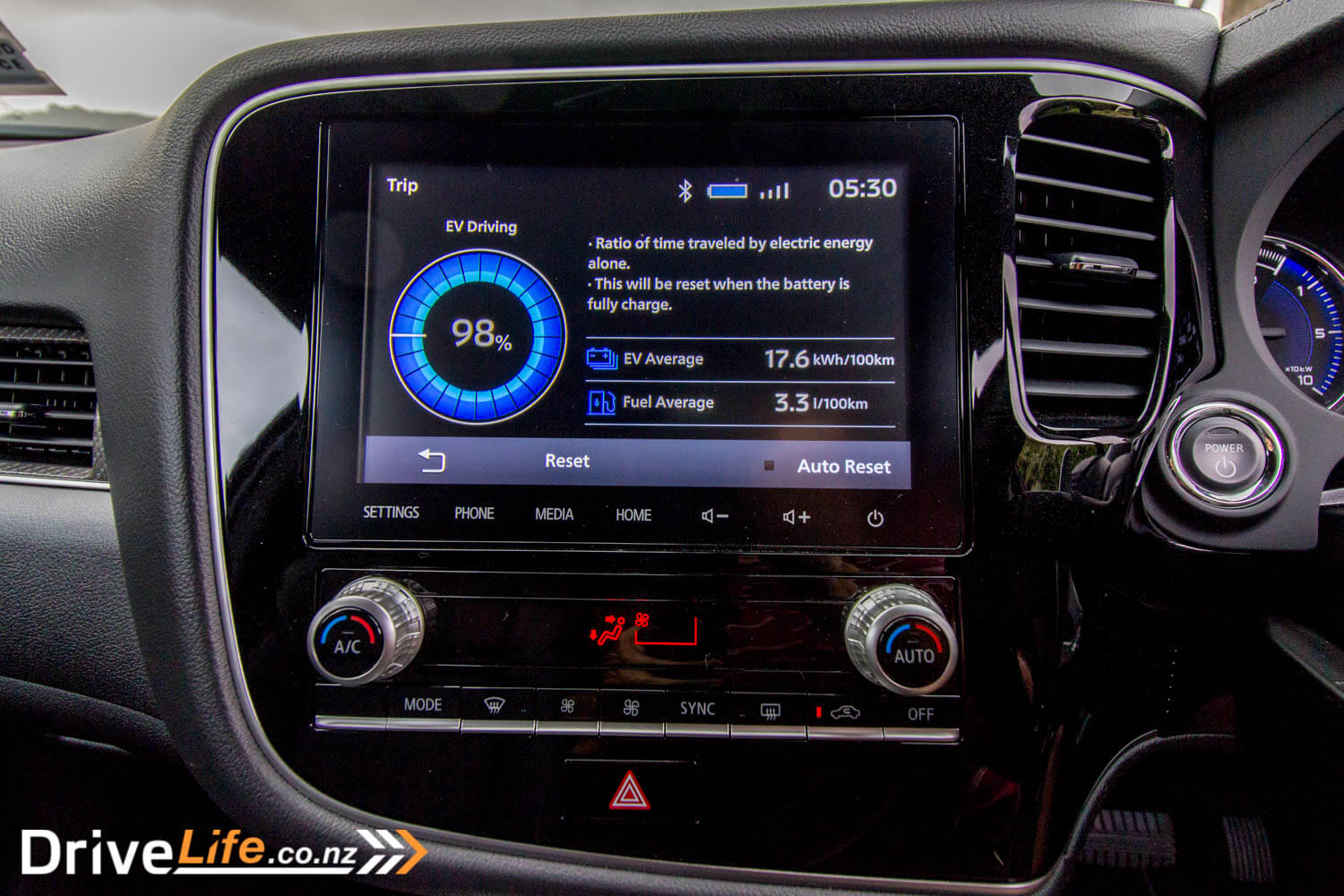
What about the rest of driving the Outlander PHEV? I think I’d call it mostly good, with a few quirks. For instance, something I noticed on the ASX too was when you give the washers a quick pull, and then you get 5 long squirts of water across the windscreen. If you like a clean car, this won’t impress you, as water streams down all the side windows and doors. You’d think a short pull of the wipers would give you only a squirt or two, but it’s 5 squirts every time.
There’s adaptive cruise control on the VRX, and it’s much appreciated. That said, it has a few little gotchas. It doesn’t bring the car to a stop, and instead you get a warning to brake. If you are using brake auto-hold, this doesn’t work after stopping on adaptive cruise, instead you get a warning to put your foot on the brake pedal, because if you don’t, the car will roll forward. EV mode is cancelled by adaptive cruise, as is any brake regen setting you have on.
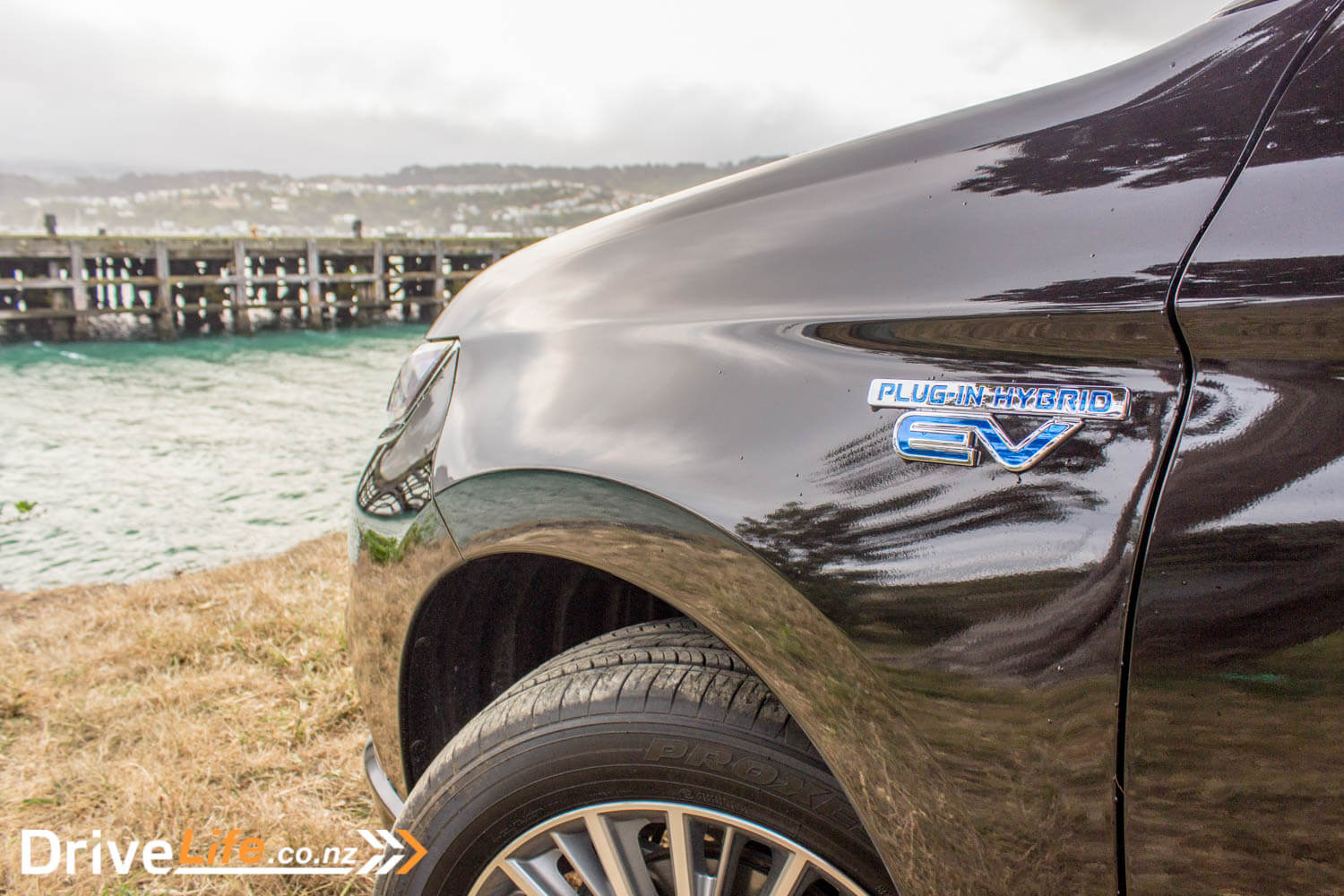
Still, who doesn’t love adaptive cruise – it’s one of the safest ways to navigate rush-hour traffic.
Visibility from the PHEV is bordering on superb; those huge side windows help enormously, as does the blind spot monitoring. It may be an SUV on the larger side, but it’s easy enough to chuck it around city streets. All windows are auto up and down, and this is something always appreciated – especially when coming back to the car and it’s built up heat inside. A push of each window button makes a huge difference.
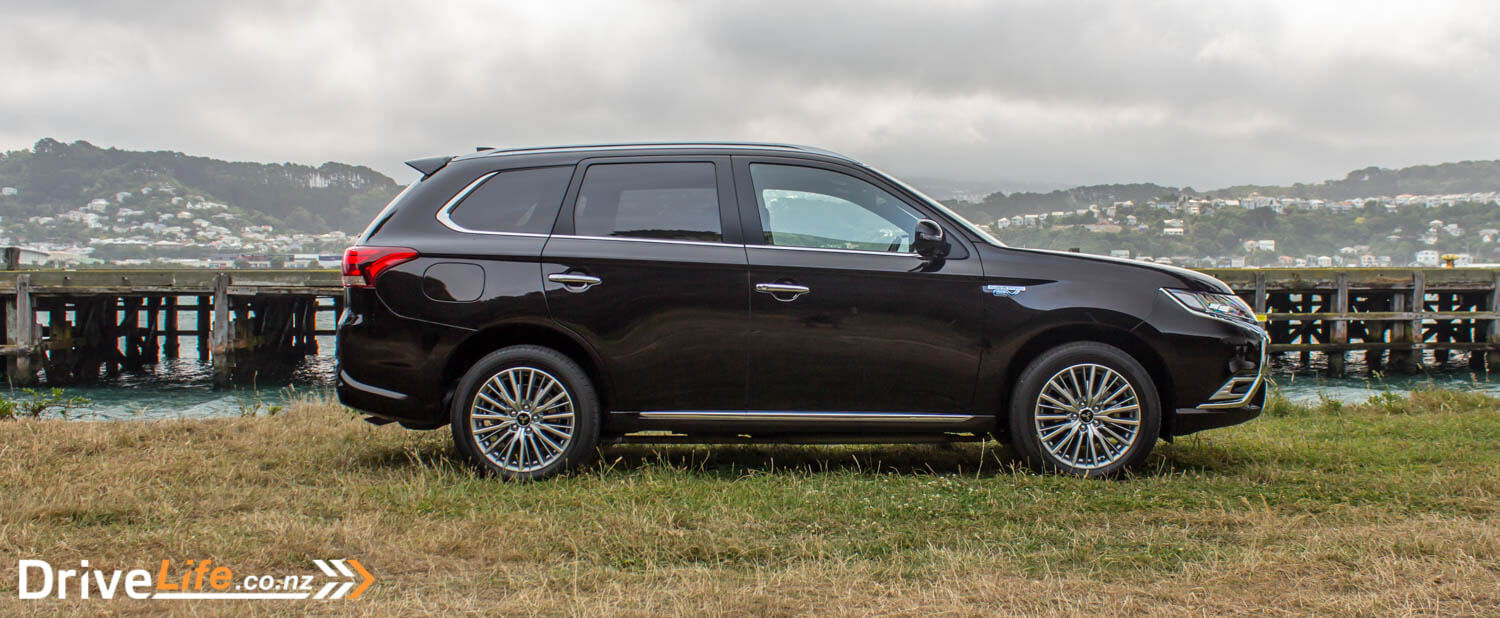
One more quirky thing about the Outlander PHEV, and I found this in the previous model. There’s an electric tailgate, and this is opened by a switch on the dash, or the key fob – but not from the door itself. There is a switch on the outside of the tailgate, but on pressing it you have to manually open the tailgate. According to the manual, if you want to open electrically, you have to ask your local Mitsubishi dealer to set it up for you. Weird.
Up front of the car, you get a 12-volt power socket and a single USB port for audio, or charging a device. Rear passengers get a USB port as well, along with acres of space back there that I’ve already mentioned. In a lot of ways, the Outlander PHEV is a great family car, and having such big rear side windows (cuts down on car sickness) and loads of space is going to win some families over.
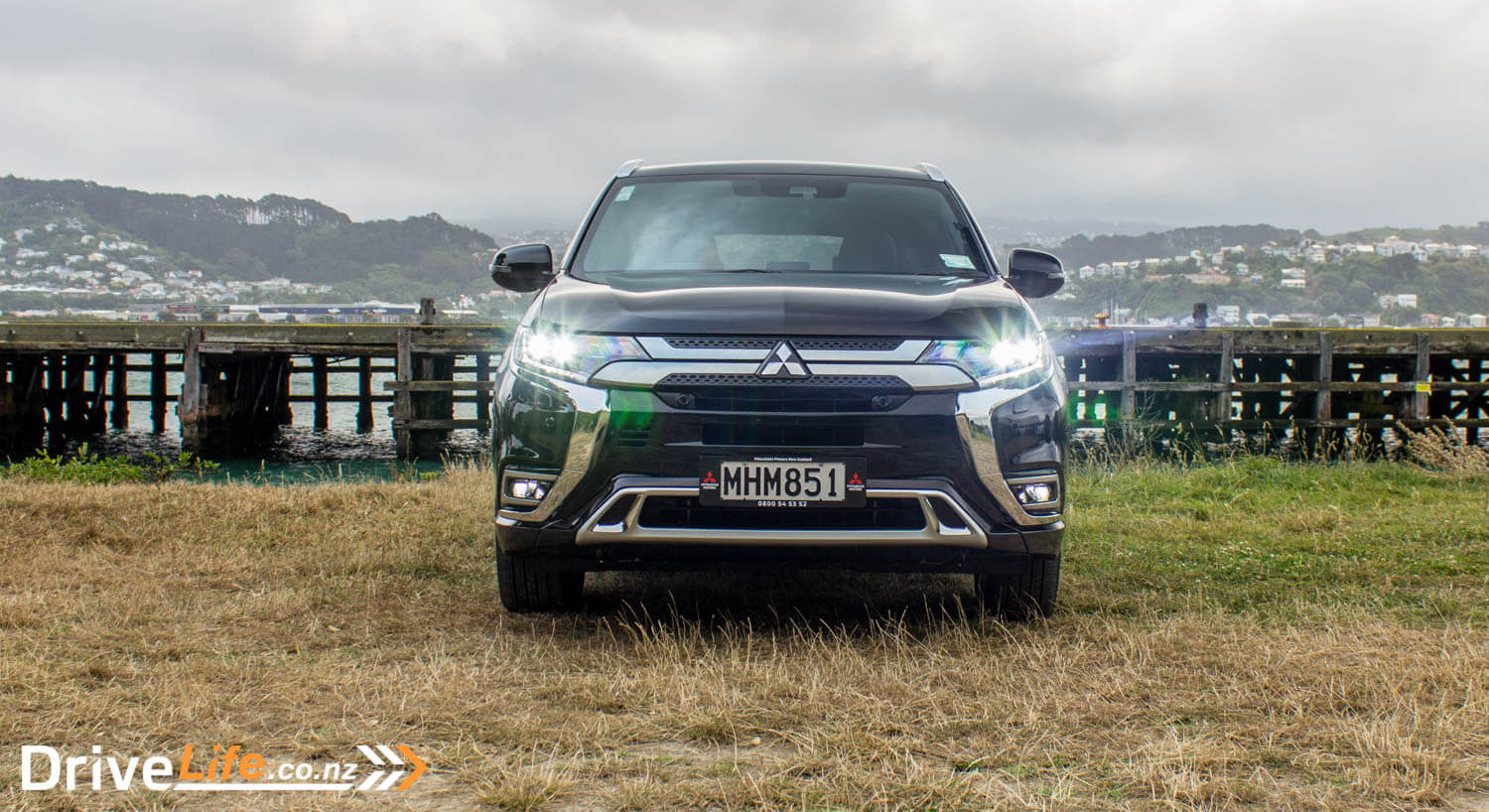
Back up front, there’s Mitsubishi’s standard infotainment system. I mentioned this about the ASX as well – there’s a home page, but it’s just shortcuts to other menus. The home page looks really clunky and low-res, but it does the job. Of course there’s a new menu option which allows you to check your PHEV data, like trip history and where the car is getting its driving force from using the energy flow meter. They are quite handy, but I did notice if you were using Bluetooth to make a phone call, all the menu options were greyed out, so you (or your passenger) couldn’t choose any of them while talking.
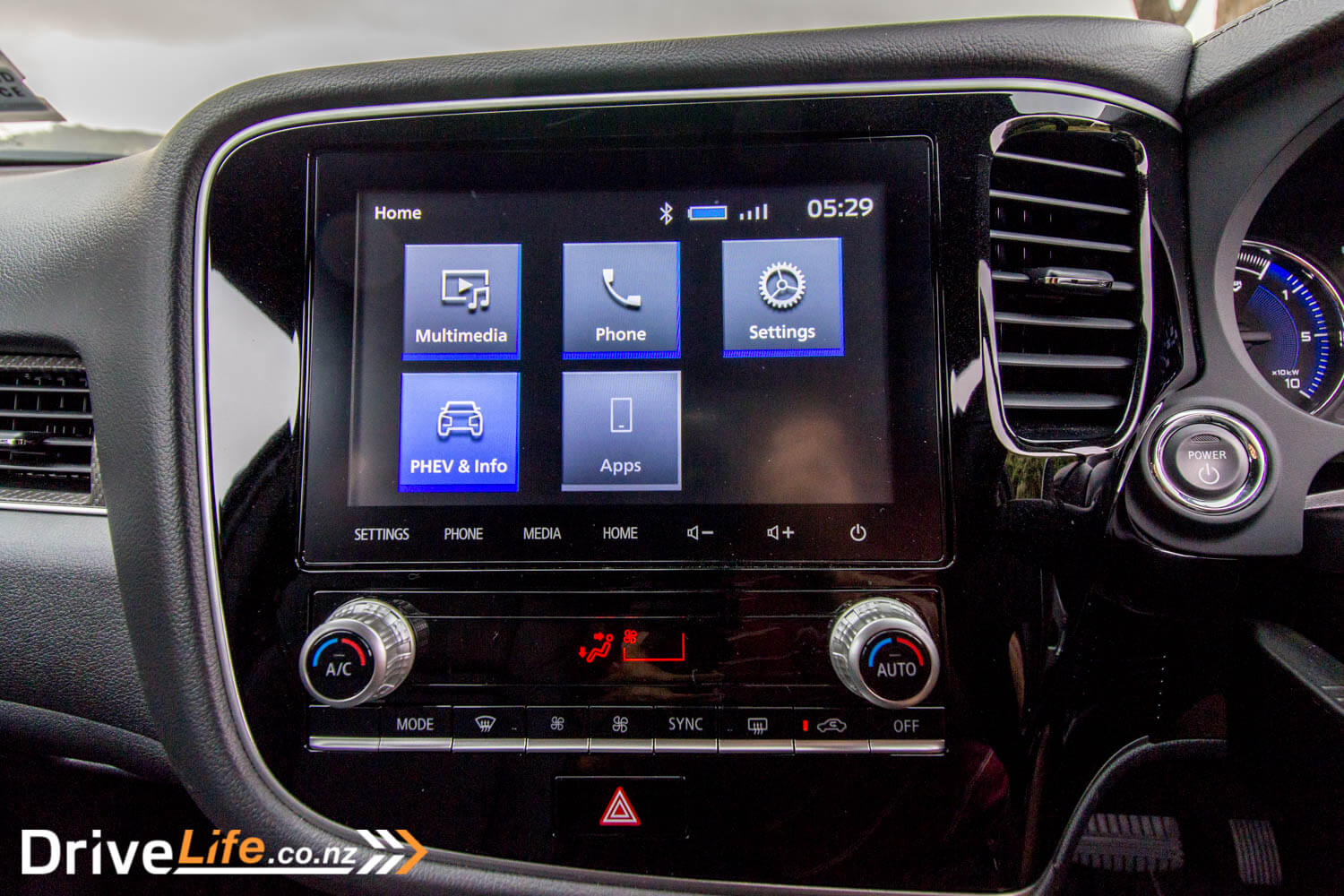
Some passengers were very surprised at the smoothness of the Outlander PHEV, when it switches from battery only to using engine to either charge the batteries, and/or drive the front wheels. The only real indication you get that something has happened is if you hear the engine going. That’s pretty much it. As a plug-in hybrid, the PHEV is an easy drive.
So, what about fuel economy? Is Mitsubishi’s claim of a combined rating of 1.9l/100km realistic, or totally optimistic? I can honestly say that my 665km of driving the Outlander PHEV was as close to combined rating as I could get. It was an excellent mix of suburban, city, highway, and country roads. I managed to average 2.8l/100km, and I’ve got to say, that’s still pretty impressive. Being able to use battery only up to around 50km is a huge boon to fuel economy.
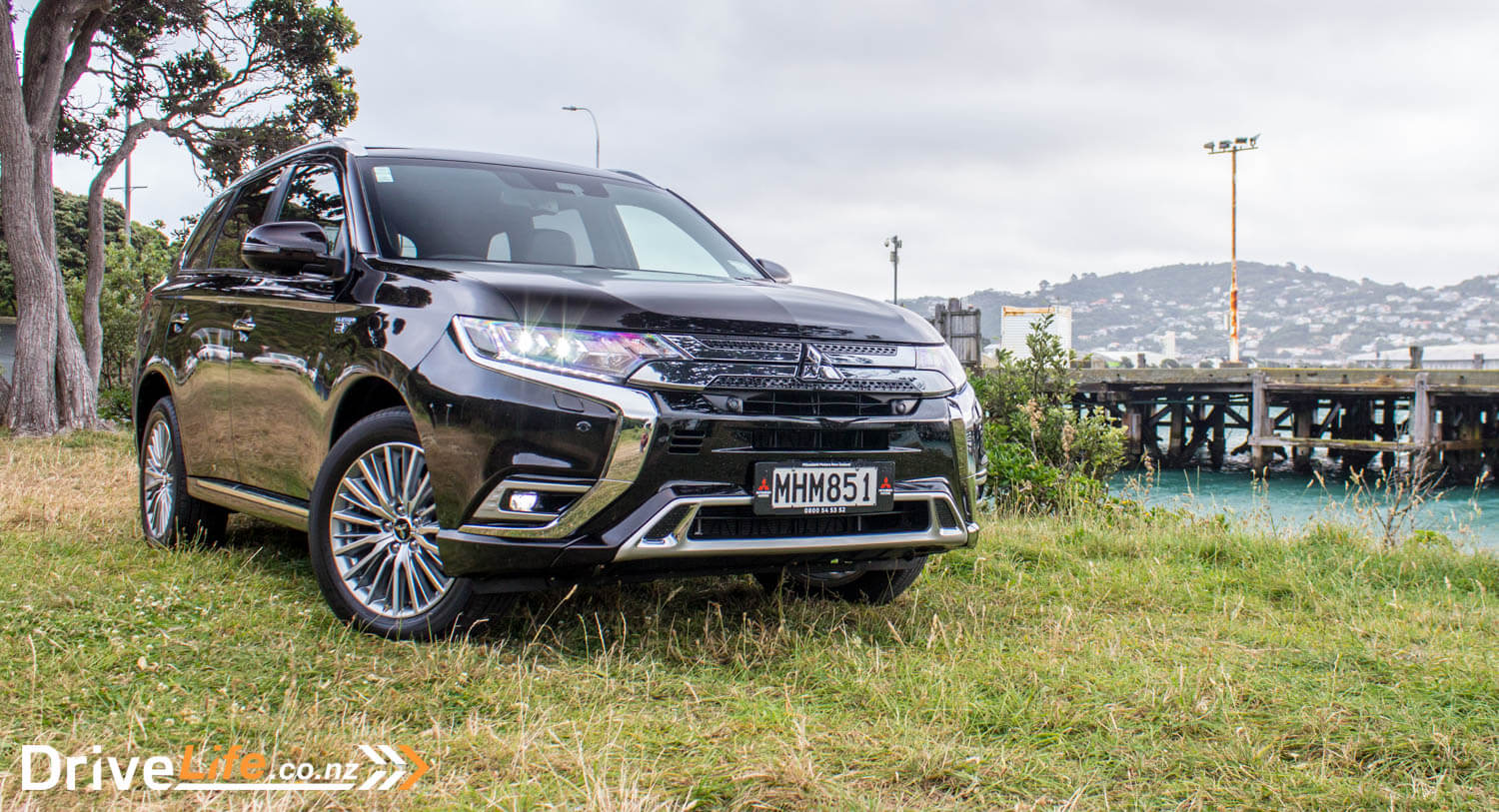
For some drivers, 50km of range may mean they won’t need to run the car on petrol for a very long time. One person asked about the fuel if the engine didn’t start for a long time, would it go off, or stale? The Outlander PHEV has some smarts around this, and will automatically start the engine if the fuel level hasn’t changed in three months. The engine will charge the battery up and then stop.
And the range? I mentioned that the range in total (fuel+EV) when I picked the car up was 550km. After 350km of driving, I still had over 500km left in the ‘tank’, and at the end of my 665km, still had 367km to go. So a repeat of my last test – I could easily achieve 900+ kilometres from a tank of gas – maybe more. With a tank size of 45 litres and this size of SUV, that’s pretty impressive. My EV usage over the whole time was 17.7kWh/100km.
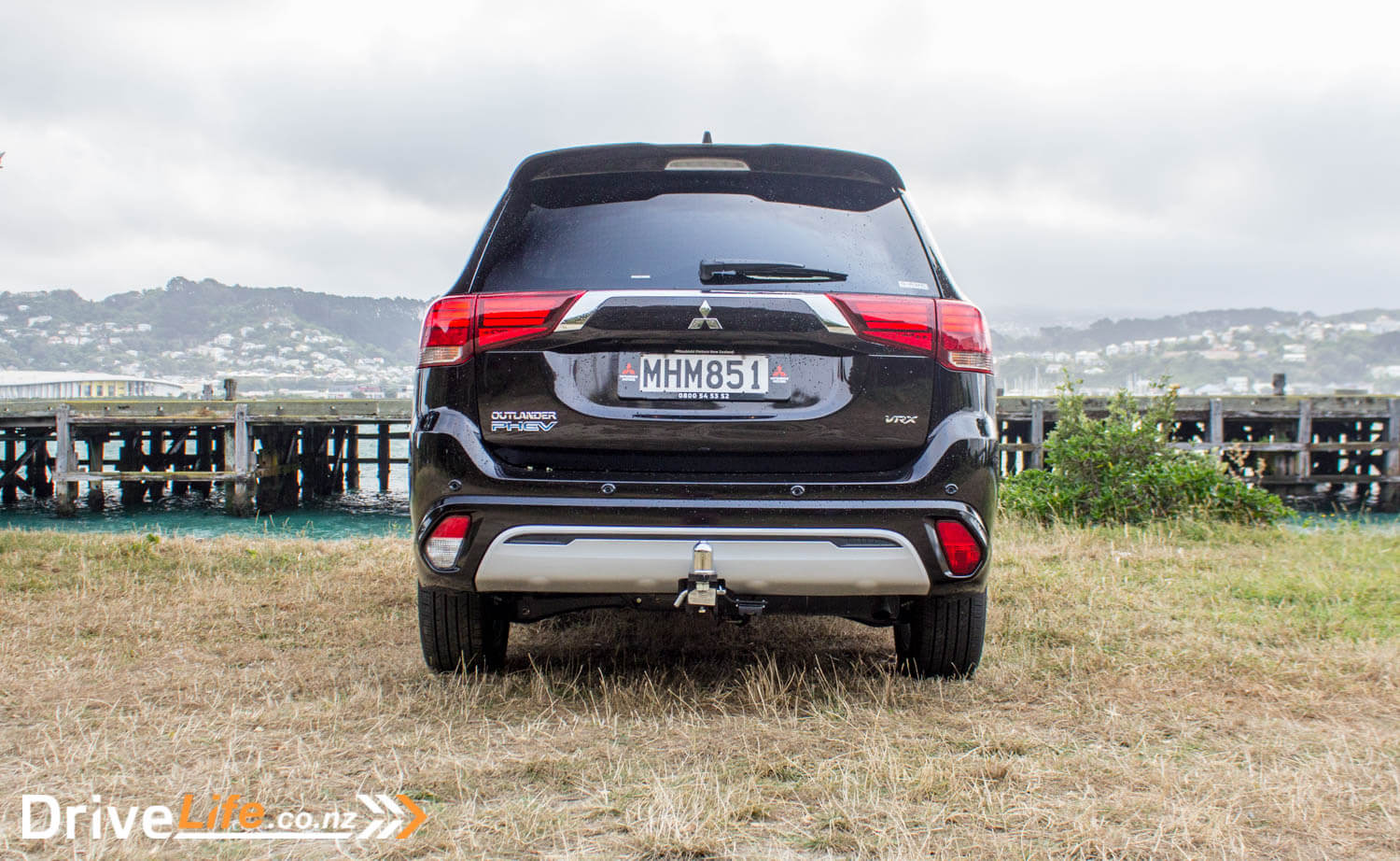
As far as charging goes, all I did was plug it in at night, and walked away. If we went out, I’d unplug it, then plug it in again on our return. It’s really that simple. If you are away and want to charge it up on a Fast Charger, it will take around 25 minutes to get the battery pack to 80% charge.
My actual cost of charging at home – if that battery was completely flat – would be $2.76. That is based on my 24/7 electricity rate of 20 cents per kilowatt of power used. Bear in mind that’s charging it from flat to 100%, and would get me around 45km for my $2.76. If you worked out a petrol cost based on the Outlander petrol VRX, that car is supposed to use 7.2l/100km. If you guess that the average national price for 91 is $2.20/litre, that’s roughly double the cost to go 50 kilometres compared to the Outlander PHEV.
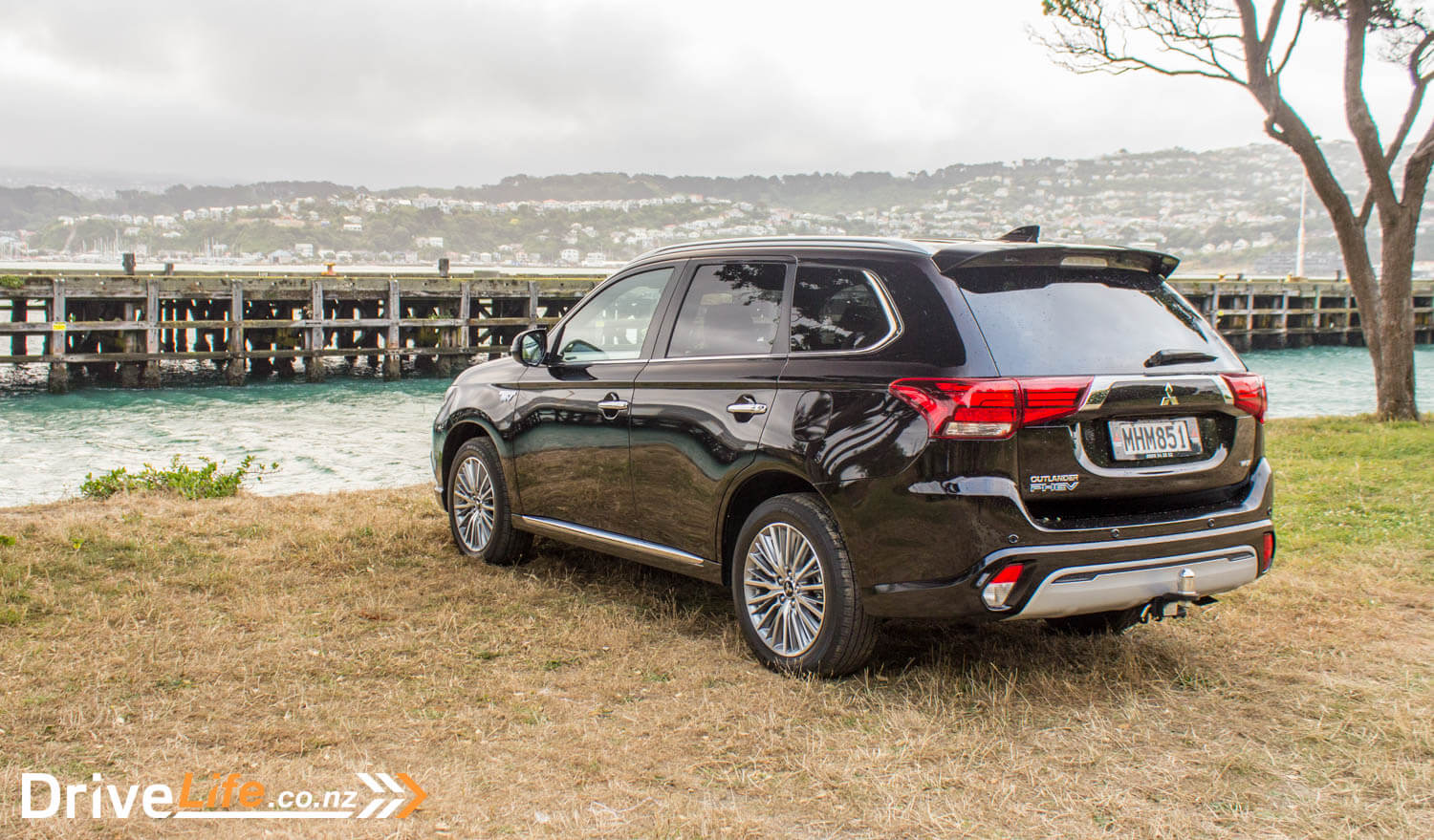
What’s The Competition For The 2020 Mitsubishi Outlander PHEV VRX?
She’s slim pickings if you want a hybrid SUV that can plug in to charge up. Check back here in a year – there’s bound to be a whole lot more available then.
| Brand/Model | Engine | Power/Torque kW/Nm | Cargo capacity, litres | Fuel L/100km | Price |
| Mini Cooper S E All 4 Countryman | 1.5-litre, 3-cylinder petrol/PHEV | 165/440 | 405 | 2.5 | $59,990 |
| Mitsubishi Outlander PHEV VRX | 2.4-litre, 4-cylinder petrol/PHEV | 94/199 | 463 | 1.9 | $57,990 |
| KIA Niro Hybrid LTD | 1.6-litre, 4-cylinder petrol/PHEV | 104/147 | 324 | 1.3 | $55,990 |
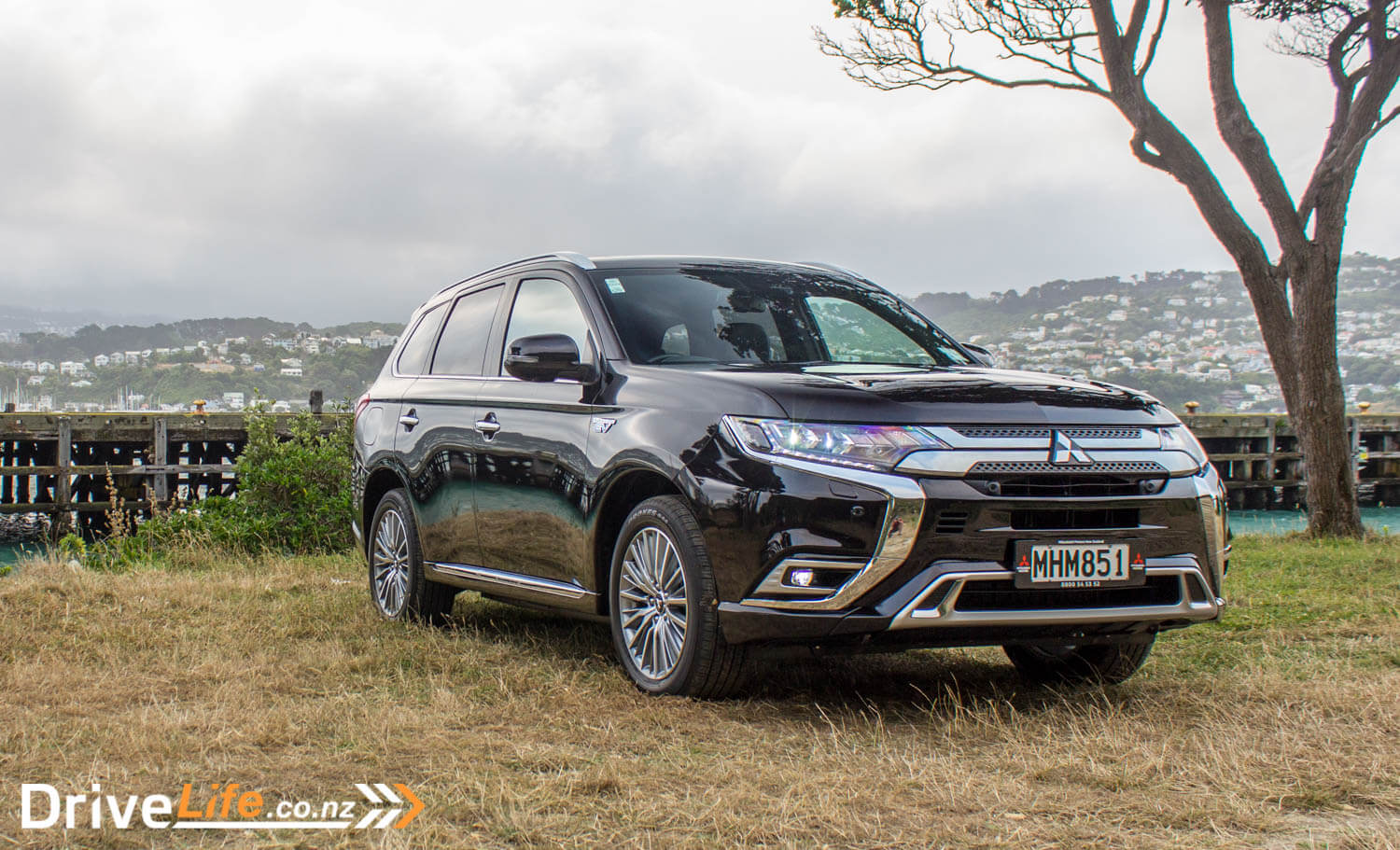
What’s The Pros and Cons For The 2020 Mitsubishi Outlander PHEV VRX?
| Pros | Cons |
| Fuel economy General space Rear legroom Value for money Visibility | CVT flaring on full throttle Headroom All-black interior Electric tailgate operation |
What’s The Verdict For The 2020 Mitsubishi Outlander PHEV VRX?
When we test a full EV, we still (always) get people asking ‘how far they can go’, as if they drive 500km per day. Some people do drive 500km per day, but the average Kiwi drives just 27km a day. The Outlander PHEV can easily achieve this on battery alone.
For those who want to put a foot into EV land but can’t quite bite the bullet, the Mitsubishi Outlander PHEV is a perfect stepping stone. It’s spacious, quiet, economical, well specced and well-priced. You can’t ask for much more than that.
When John last reviewed the Outlander PHEV in 2018, he gave it a 4.5-Chevron rating. Sorry, Mitsubishi – I can’t give it 5. There’s just a few too many quirks for me for a 5 rating, but still – if this is the sort of wagon you are after, it’s a great fit. I’d be happy with one in my driveway.

2020 Mitsubishi Outlander PHEV VRX – Specifications
4.5 Chevrons
| Vehicle Type | Medium SUV |
| Starting Price | $68,990 |
| Price as Tested | $57,990 |
| Engine | 2.4-litre, four-cylinder petrol/hybrid system with PHEV |
| Transmission | CVT |
| Power, Torque kW/Nm | 94/199 |
| Spare Wheel | Pump only |
| Kerb Weight, Kg | 1,880 |
| Length x Width x Height, mm | 4695x1800x1710 |
| Cargo Capacity, litres | 463/886 |
| Fuel Economy, L/100km | Advertised Spec – combined – 1.9 Real World Test – combined – 2.8 Low Usage: 0-6 / Medium Usage 6-12 / High Usage 12+ |
| Fuel tank capacity, litres | 45 |
| Towing Capacity Kg, unbraked/braked | 750/1500 |
| Turning circle, metres | 10.6 Small: 6-10m / Medium 10-12m / Large 12m+ |
| Warranty | 5 year, 100,000km warranty 8 year/160,000km battery warranty 5 years Premium Roadside Assistance |
| ANCAP Safety Ratings | 5 Star |

